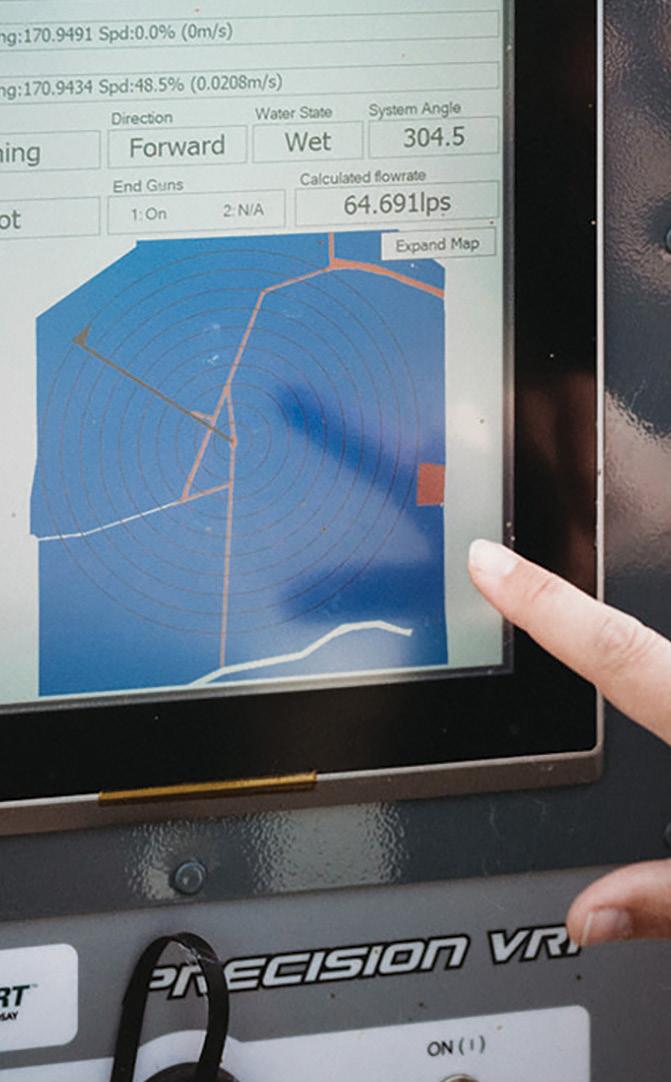WATER REFORM AND INFRASTRUCTURE
LONG-TERM WATER STORAGE OPPORTUNITIES

WATER REFORM AND INFRASTRUCTURE
LONG-TERM WATER STORAGE OPPORTUNITIES
Driving agricultural growth through smart water management
WATER STORAGE WIN FOR HAWKE’S BAY



Lowara
Z Series
6” 8” 10” & 12” Submersibles
Brown Brothers Engineers have all your irrigation pumping solutions.

• Stainless steel
• Hard wearing
• Corrosion resistance
• High efficiencies
• Low running costs
Goulds
ISO Series
Single stage end suction pumps
• Cast iron casing / Stainless impellers
• Flexible design
• Highly efficient
• Low maintenance
Scan the QR code below to see how Lowara & Gould’s premium pump ranges can assist with your water requirements.

REGULAR
4 FROM THE CHAIR / Keri Johnston
5 FROM THE CHIEF EXECUTIVE / Karen Williams
6 OUT & ABOUT
8 VIEW FROM HERE / The Hon James Meager
10 VIEW FROM THERE / Andrew Kneebone, Tasmanian Irrigation
28 TECHNICAL / Unlocking water storage opportunities
38 Seasonal climate outlook
40 DID YOU KNOW? / The distribution of water in the world
FEATURES
13 IrrigationNZ annual survey
15 Let’s talk about water storage
18 TIM CADOGAN / Central Otago water reform and infrastructure
20 Next steps in Heretaunga water security confirmed
23 Students showcasing freshwater innovation
34 TRAINING / Train to help shape the future of irrigation
36 Site Safe Foundation Passport – Civil (Irrigation)
42 BRIAN CAMERON / Farmer, author, and agriculture pioneer




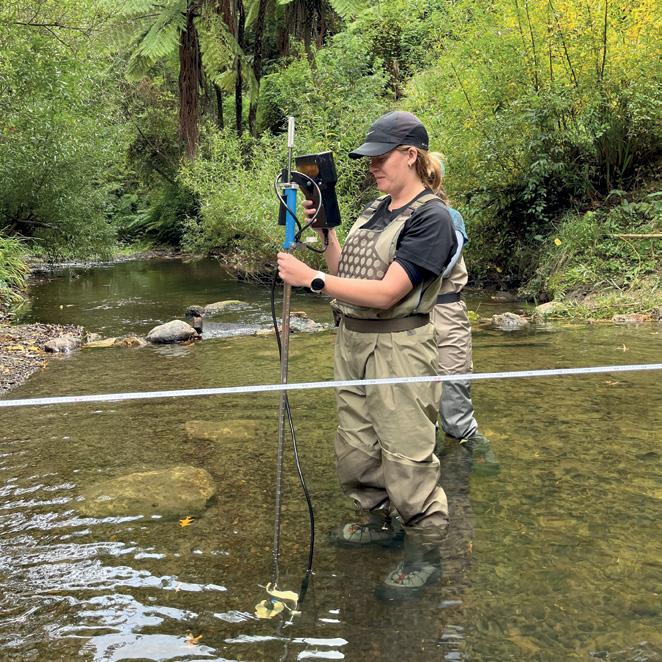
EDITOR/ADVERTISING Kath Healy / 027 253 8089 / khealy@irrigationnz.co.nz DESIGN Rosie Fenton PRINTING Caxton
PUBLISHED BY Irrigation New Zealand / PO Box 8014, Wellington 6143, New Zealand DISTRIBUTION New Zealand Post
COVER PHOTO Courtesy of Tasmania Irrigation ISSN 2230-5181
Please email admin@irrigationnz.co.nz if the delivery address/information where this magazine has been received is incorrect or needs updated. IrrigationNZ News is published by Irrigation New Zealand Inc (IrrigationNZ) four times a year. The circulation includes all IrrigationNZ members. The opinions expressed in IrrigationNZ News do not necessarily reflect the views of IrrigationNZ. The information contained in this publication is general in nature with every effort being made to ensure its complete accuracy. No responsibility can be accepted for any errors or copyright breach that may occur beyond the control of the editor or IrrigationNZ. Permission must be sought from the Editor prior to reproduction of any material contained in this publication.
www.irrigationnz.co.nz

Keri Johnston Chair IrrigationNZ
Welcome to the autumn edition of IrrigationNZ News.
The team at IrrigationNZ have had a busy start to 2025. By the time this has gone to print we will have welcomed our new CEO, Karen Williams. Karen is a collaborative leader who is very wellconnected and respected across the political spectrum, and we are thrilled to have her join our team.
In the interim period, we were in the very capable hands of Stephen McNally. We cannot thank Stephen enough for his steady leadership and his sheer passion for our organisation. Stephen’s dedication and commitment have been instrumental in maintaining momentum and ensuring a smooth transition during this period.
Prior to Christmas, we welcomed Kath Healy to the team as our government relations and communications manager. Kath brings a wealth of experience and a fresh perspective to our communications, and her contributions have already made a significant impact.
IrrigationNZ now has a full house again, and with signs we are going to have an incredibly busy year, we are very fortunate to have such an amazing team. Our team is not only complete but also highly motivated and ready to tackle the challenges and opportunities that lie ahead. The synergy and collaboration within the team are palpable, and we are excited about the prospects for the coming months.
Resource Management Act reforms, review of the National Policy Statement for Freshwater Management and accompanying standards, potential development of new standards, and ongoing matters such as the Dam Safety Regulations are all on the cards for the first half of the year. These legislative changes are critical for the future of our sector, and we are actively engaging with policymakers to ensure that the interests of our members are well-represented. We are continuing to advocate strongly for the recognition of irrigation as critical infrastructure, or nationally significant. All of the legislative reform underway or coming will allow us to do this. Recognising irrigation as critical infrastructure is essential for securing the necessary support and resources to sustain and enhance our irrigation systems. This recognition will also underscore the vital role that irrigation plays in food security, economic development, and environmental sustainability.
Our advocacy activities are supported by our training activities – our advocacy is more credible when we are able to demonstrate that we are leading our sector, training members of our sector, and setting our standards. We have many training options available to meet the varying needs of our service sector and those at grass roots level.
Our training programmes are designed to equip our members with the latest knowledge and skills, ensuring that they are well-prepared to meet the evolving demands of the industry.
Check out our website for all of the training options available. Our training offerings include workshops, webinars, certification courses, and hands-on training sessions. These programmes cover a wide range of topics including technical skills, best practices, regulatory compliance, and sustainability. By participating in our training programmes members can stay ahead of industry trends, enhance their professional development, and contribute to the overall advancement of the sector.
Until next time,
Keri

Karen Williams Chief Executive IrrigationNZ
Kia ora everyone,
I’m absolutely thrilled to now be in this role and I want to pass on a huge thank you for all the warm welcomes. It’s been great hearing from so many of you already, and I’m looking forward to helping deliver some of the much-needed outcomes we all care about.
One of the things I’m most excited about is getting out and meeting the wider water user community – hearing your thoughts, concerns, and ideas firsthand. Please be patient as I settle in and work through some must-dos before I get an engagement schedule underway.
There are huge opportunities ahead for us to progress water storage and strengthen community water resilience, something that aligns strongly with the Government’s goal of doubling exports.
The recent bounce-back in farmer confidence (as shown in the latest Federated Farmers survey) is great to see – that said, we want that confidence to extend right across the primary sector.
Of course, the recent variable weather across the country has once again highlighted the importance of sound water storage investment.
For some regions, irrigation and storage have been a lifeline; for others, the challenges have been a stark reminder of why we need to push forward. IrrigationNZ is here to support these conversations and help drive real progress in this space.
I want to acknowledge Vanessa for her contribution to IrrigationNZ over the last few years. I’m looking forward to working with her in her new role at the Ministry for Primary Industries, which will help to keep momentum up.
I’d like to give a special shout-out to Stephen, whose steady leadership, along with the mahi of Julie, Nick, Lynn, and Kath has kept everything moving forward while we transition at the helm.
The conversations I’ve had so far have only reinforced the deep respect that our members and stakeholders have for this team. I feel incredibly fortunate to be joining such a passionate and committed group.
We all know it’s going to be a busy year, and I can’t wait to build new relationships and reconnect with many of you.
Here’s to rolling up our sleeves and seeing what we can achieve together.
For some regions, irrigation and storage have been a lifeline; for others, the challenges have been a stark reminder of why we need to push forward. IrrigationNZ is here to support these conversations and help drive real progress in this space.
Pictured here are new IrrigationNZ CEO Karen Williams and Tony McCormick, CEO of Rangitata Diversion Race Management Limited. This is the intake to the Rangitata Diversion Race (RDR) just below the gorge on the Rangitata River. The river happens to be very low (approximately 45 cubic metres per second in this shot), and the diversion into the RDR has been reduced as required by their consent. Just downstream of the intake, Karen was able to see the RDR Fish Screen – considered to be the largest facility of its type in the Southern Hemisphere. The RDR is New Zealand’s largest water supply scheme. It operates all year round, providing water for over 100,000ha of irrigation in the summer period, and stock water and hydro generation continuously. It is often referred to as ‘the lifeblood of Mid Canterbury’.


Karen Williams and Stephen McNally recently attended Central District Field Days, which was held 13–15 March in Feilding.
Karen chatted with Dean Williamson (left), publisher of Farmers Weekly, and Sarah Von Dadelszen (middle), FMG Chairperson.
Karen visited Rangitata South Irrigation Limited (RSIL), a large facility on the Rangitata River, at Arundel. The facility comprises a series of seven large ponds (16m3 of storage) designed to capture flood flow water when the Rangitata River flow exceeds 110 cubic metres per second.
In the adjacent picture of Karen with RSIL operations and maintenance technician James Yates, the pond in the left of the image is empty; the water race on the right is diverting some water under a water swap arrangement between Rangitata Diversion Race Management Limited (RDRML) and RSIL.

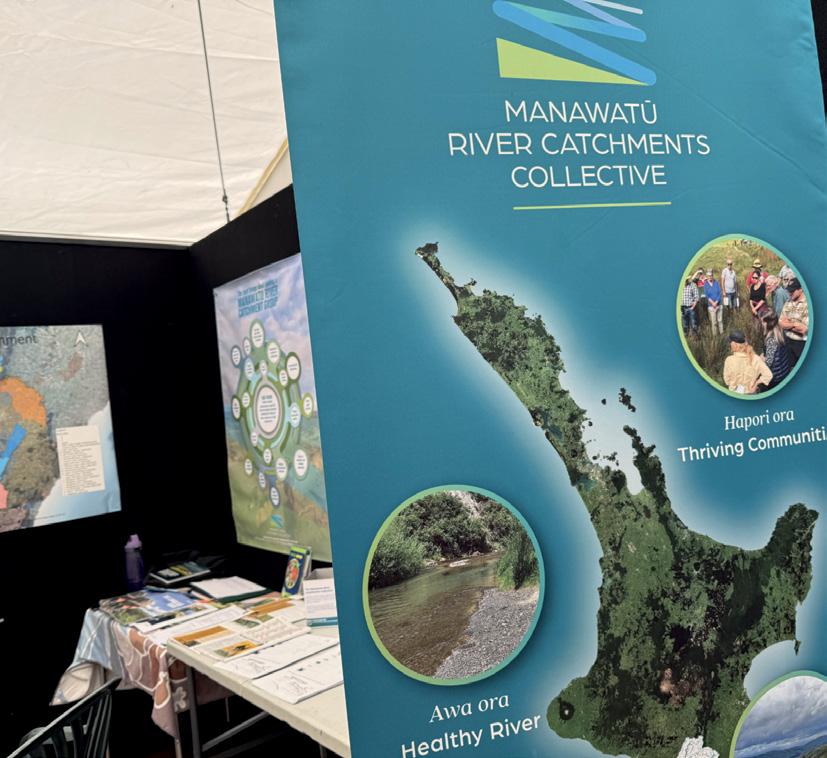

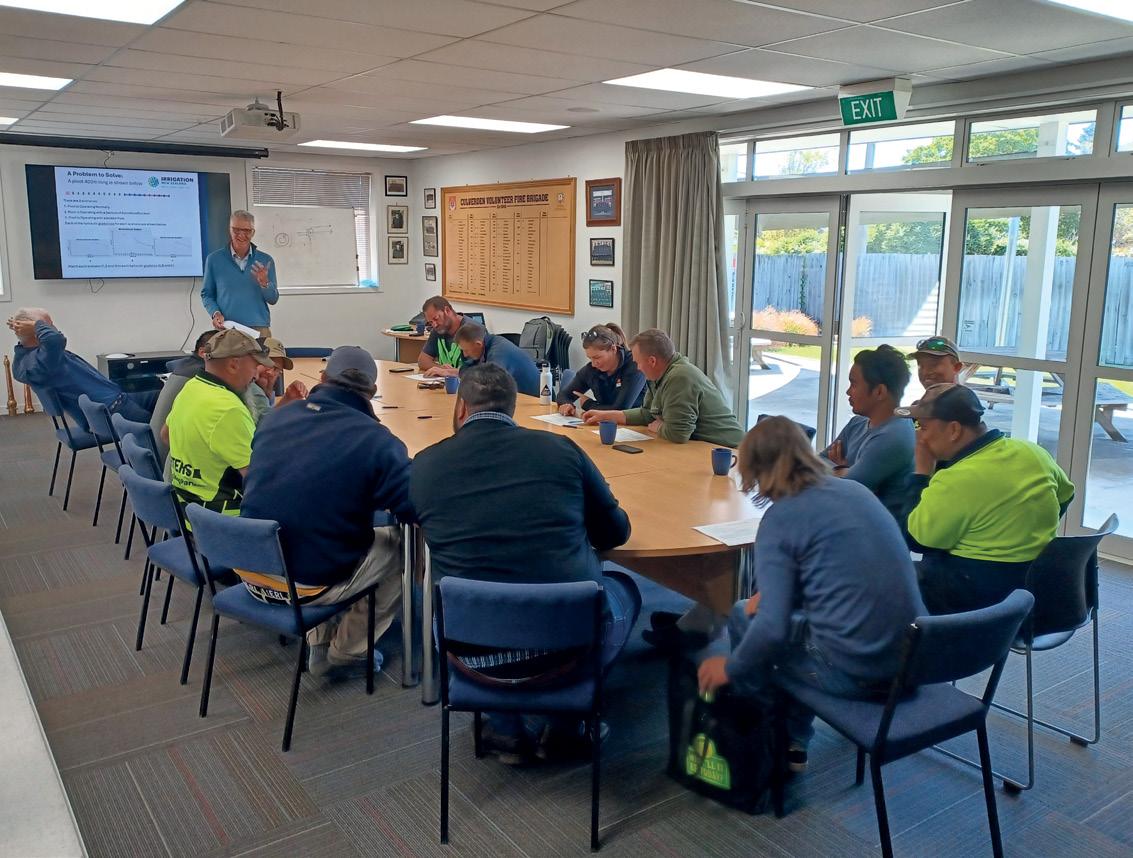
Our principal technical advisor, Nick Adams, is seen here delivering a workshop on Irrigation Efficiency. Joining him were farm managers and staff from farms connected to the Amuri Irrigation Company in North Canterbury. During this part of the day, they were successfully working through a hydraulic grade line exercise.
Also pictured is Nick Adams next to the Waiau River irrigation supply race, just downstream of the Waiau River Intake – making the most of time en route to the workshop at Amuri.


Stephen (left) and Karen (right) had a laugh with Gwyn Jones from the Manawatu River Catchments Collective.

Karen met with the CEO of Opuha Water Limited, Bjorn Triplow. Opuha Water Limited monitors water quality of Lake Opuha and surrounding waterways, while promoting good environmental and irrigation practices for farms in South Canterbury. Lake Opuha provides water to maintain environmental flows in the downstream catchment, for irrigation, and as urban and industrial supplies. Water storage is prioritised for release into the Opuha River, which flows into Opihi River, to ensure minimum flows are maintained at all times, especially in times of drought and/or low natural flows.

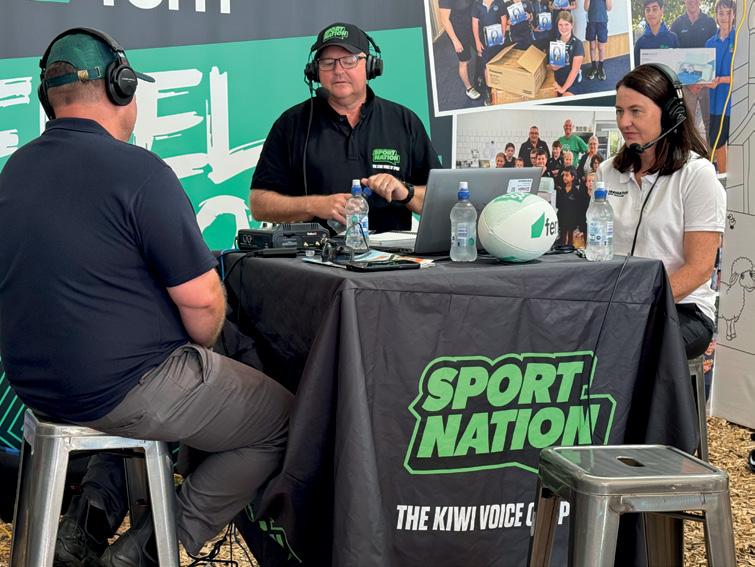
Just before radio interviews, Karen caught up with a former Federated Farmers colleague, Tania Thomas (middle), and The Hon Mark Patterson, Minister for Rural Communities and Associate Minister for both Agriculture and Regional Development, (right) who was also going on air. Then into action with a live interview on Sport Nation’s The Rural Roundup.

The Hon James Meager National Party MP for Rangitata Minister for South Island, Hunting & Fishing, Youth, and Associate Minister of Transport
As both the Minister for the South Island and the Member of Parliament for Rangitata, I have had the privilege of seeing firsthand the incredible diversity and beauty of the South Island – its rivers, lakes, and aquifers have long been the lifeblood of our communities and our economy. From the agricultural heartlands of Canterbury to the pristine waters of Fiordland, our waterways have sustained generations of New Zealanders, both in our urban centres and rural towns –and will play an important role in sustaining many more generations to come.
The role that water has played in our country’s economic and cultural history is undeniable. Throughout my early engagements as South Island Minister, it is an area that has been brought up time and time again. We know that there is still so much more that we can do, and I’m here to advocate to ensure the South Island gets the investment it needs.
The creation of the South Island portfolio is an acknowledgement by the Prime Minister, and our Government, of the huge role that the South Island will play in our country’s economic growth story. The role that the Prime Minister has outlined for me is one of advocacy and coordination, taking an all-of-government approach, and an oversight approach, to decisions that affect the South Island.
Having your voice heard on water storage will be one of the issues for which I will advocate.
Water is one of the most precious resources that we are blessed to have in
abundance here in New Zealand. Many countries around the world can only dream of having the quality and quantity of water that we have. We must ensure that we are getting the most out of it; that is why it is critical that we work together to unlock the economic potential that water storage, capture, and use brings – because not only will that strengthen our economy, but it will also strengthen the social and economic fabric of our communities. We are amending the Resource Management Act to make it easier and cheaper to build water storage.
The way we manage our water resources has to be done with an eye on the future. Our current needs must be met without compromising the ability of future generations to meet theirs. That is why water infrastructure –which helps deliver water reliably to farms and ensures it is used efficiently – is critical to our long-term success. The Government is already backing this vital infrastructure with the right policies, recognising that a robust and reliable water supply is key to maintaining our agricultural production while preserving the natural environment.
Farmers know how crucial reliable water is to their operations. It provides them with the flexibility to decide when to irrigate, ensuring that they can make the most of their land while reducing wastage. Efficient water use means that irrigation is applied ‘just in time’, rather than ‘just in case’, minimising unnecessary consumption while still meeting the needs of crops and livestock. This, in turn, helps ensure the sustainability of our primary sector and the wider economy.
The way we manage our water resources has to be done with an eye on the future. Our current needs must be met without compromising the ability of future generations to meet theirs. That is why water infrastructure – which helps deliver water reliably to farms and ensures it is used efficiently – is critical to our long-term success.
However, as we face the realities of climate change, we need to prepare for a future with greater water demands and more variable supplies. This means more investment in water distribution networks and storage solutions. Long-term water allocations, supported by efficient infrastructure and the ability to store water for drier times, will be essential. When river flows are low, we can rely on stored water to supplement supply and ensure that our regions continue to thrive.
Water storage not only strengthens our resilience to drought, low flows, and extreme weather events, it also supports a wide range of land uses. It enables the primary

sector to meet its export growth targets, supports social and cultural aspirations, and protects our environment by reducing strain on river systems. By using water more efficiently and strategically, we can ensure that New Zealand’s regions continue to prosper, balancing economic growth with environmental and community well-being.
The future of water management in New Zealand, particularly in the South Island, is a shared responsibility. Government, local councils, businesses, and communities must work together to ensure that we not only protect our waterways but also use them in ways that drive prosperity and wellbeing for all New Zealanders. This will require careful planning, investment in infrastructure, and a commitment to sustainable practices that support our land and our people. However, through smart investment, careful planning, and sustainable practices, we can ensure that the South Island and our entire nation remain a land of opportunity for generations to come.
We have an incredible opportunity ahead of us to build a resilient, sustainable water management system that benefits everyone. Let’s make the most of it.
When it comes to securing the future of agriculture, access to reliable water is a game-changer.
In Tasmania, that challenge has been met head-on by Tasmanian Irrigation, a stateowned organisation dedicated to developing and operating irrigation schemes that support farmers and rural communities.
We asked Andrew Kneebone, the outgoing CEO of Tasmanian Irrigation, to share some insights on the organisation’s journey, the lessons learned, and the future of irrigation in Tasmania and beyond.
Andrew has been with Tasmanian Irrigation for nearly seven years, spending most of that time as CEO. What drew him to the role? A love for Tasmania and a deep background in the water sector.
“My wife and I were looking for an opportunity to return to Tasmania, and this role combined a location I love with a sector I’m passionate about,” he says.
Day-to-day, Andrew’s job has been any-

thing but routine. From managing asset maintenance and water sales to navigating government approvals and meeting with farmers, no two days have been the same.
“That’s part of the appeal,” he admits. “One moment, I’m working on reducing energy costs for water delivery, the next I’m in the field talking to irrigators about how we can better support them.”
Under Andrew’s leadership, Tasmanian Irrigation has grown into a powerhouse, on its
way to delivering more than $1 billion worth of irrigation infrastructure. For him, though, the real achievement has been building a dedicated team.
“We have a small but focused team that’s come up with innovative solutions to some big challenges,” he says.
“Together, we’ve transformed agriculture across the state.”
As for the biggest lessons? “There’s always a second right answer – there’s rarely just one solution to a problem. Never lose sight of what your customers truly value. Investing in people is always worth it. They’re my top three.”
Tasmania’s farming scene is as diverse as it gets. The island is home to everything from dairy and vegetable farms to broadacre cropping, red meat, fibre production, horticulture, and viticulture.
“We have multiple microclimates, different soil types, and a mix of areas that range from naturally wet to some of the driest

in Australia. That diversity means we need flexible, well-managed water solutions.”
Tasmanian Irrigation was set up in 2011 with a clear mission: grow the state’s agricultural sector through sustainable irrigation. With a target of reaching $10 billion in value by 2050, the organisation has already built 16 schemes and has 5 more in development.
“Our model is a three-way partnership between the Australian Government, the Tasmanian Government, and farmers,” Andrew says.
“Farmers buy water entitlements, governments provide funding, and we ensure the schemes are designed for long-term sustainability.”
The focus is on delivering high-reliability water (95 percent guaranteed) at an affordable price, using infrastructure built to last a century.
Over time, the organisation has evolved its approach, particularly in how it manages construction and environmental approvals.
“We now handle our own asset designs and only contract out construction. This gives us more control over quality and risk management.”
While Tasmanian Irrigation will eventually shift from building schemes to maintaining them, the work is far from over.
“We’ll need to keep our assets reliable and deliver water efficiently in an increasingly variable climate,” Andrew says.
As for broader opportunities, he sees strong parallels between Tasmania and New Zealand, given their similar climates and agricultural diversity.
“The key lesson is to plan for sustainability from day one. Owning the environmental
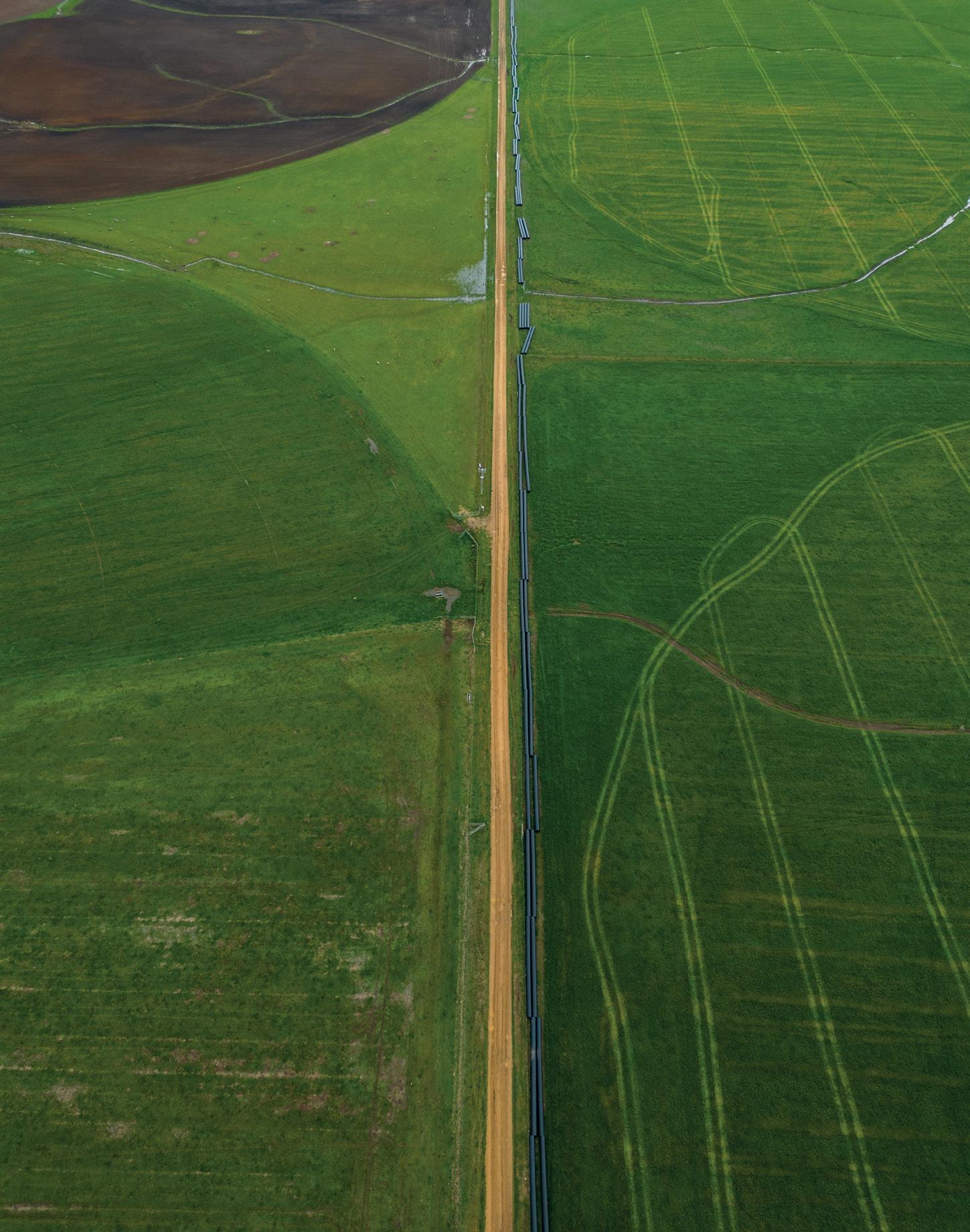

challenge up front makes a huge difference.”
Tasmanian Irrigation schemes provide a platform for establishing a robust environmental management and governance framework – the first of its kind in Tasmania. This includes implementing initiatives such as Farm Water Access Plans, which are property-specific environmental management plans designed to ensure the sustainable application of water while maintaining soil and ecosystem health.
Each Tasmanian Irrigation scheme undergoes rigorous evaluation against the significant impact assessment criteria under federal environmental legislation, as well as being developed in line with State legislative frameworks. Government funding remains a critical challenge too.
“Budgets are getting tighter, so we need to keep emphasising the economic payback –how these investments drive regional growth and stability.”

We have multiple microclimates, different soil types, and a mix of areas that range from naturally wet to some of the driest in Australia. That diversity means we need flexible, well-managed water solutions.
Andrew’s next chapter? Taking a step back from full-time work while still contributing to the water sector.
“I’m going to practice not working full time. We’ll see how that goes!” he laughs.
For Tasmania, the path forward is clear: keep investing in smart water solutions that empower farmers and strengthen the economy.
And with a model that blends public funding, private investment, and long-term sustainability, the island state is setting a benchmark for others to follow.
Can New Zealand rise to the Aussie challenge? There is plenty to learn from Tasmania and the opportunities ahead are many.
Come and listen to Andrew speak at the Primary Industries New Zealand Summit on 24 and 25 June at Te Pae, Christchurch. Tickets available at brightstar.co.nz/events/pinz




For more information contact Water Supply Products: Auckland: 09-916 0094 Christchurch: 03-348 1293 wsp@watersupply.co.nz www.watersupply.co.nz

In a recent IrrigationNZ e-newsletter to members we mentioned that we want to run an annual membership survey to benchmark where we are at and assess ways in which we might want to progress as a membership organisation.
While the first survey will go out in April this year and be open to members only, we want you all to be aware of what the annual survey will involve and why we are doing it.
If you want to be involved in the survey this year, but are not yet a member, now is the time to join!
Membership will keep you up to date with irrigation news, and connected to the future of irrigation in Aotearoa New Zealand. Visit our website or email admin@irrigation.co.nz to find out more about membership.
• Key topics that we know are common and relevant to members
• Levels of satisfaction relating to membership benefits and services
• Any improvements members would like and future-focused ideas
We’ll also ask a few open-ended questions to get to the heart of what is on the minds of our members.
• We’ll run the survey online for a couple of weeks
• We’ll then analyse the results and report key findings to members
• We’ll advise of any follow-up required as a result of feedback
IrrigationNZ has a large reach across rural, industry, and political sectors. Aside from advocacy work and leading on best practice irrigation, we are focused on finding common ground on key topics that connect to New Zealand’s wider water future.



IrrigationNZ News is a quarterly magazine published by IrrigationNZ, a membership-funded national industry body that promotes excellence in irrigation. The magazine is dedicated to information and expert advice on all topics associated with irrigation and freshwater management. IrrigationNZ News aims to:
• Provide news and information on the challenges and opportunities facing water users across all sectors and throughout New Zealand.
• Add value for individual irrigators’, scheme and irrigation industry businesses.
• Improve the general level of knowledge of good management practice by encouraging a culture of continuous improvement to contribute to positive economic, socio-cultural and environmental outcomes.
• Highlighting the value of irrigation to the wider economy and community of New Zealand.
Advertising in IrrigationNZ News is a direct link to those who irrigate across all sectors – arable, meat & wool, dairy, horticulture, viticulture and other – as well as industry, consultants, engineers, scientists, politicians, central and local government, education sector and students.
Printed copies of IrrigationNZ News are delivered to IrrigationNZ members, government officials, plus consent holders in the Canterbury region. IrrigationNZ share and promote the online issue through our social channels and in our regular e-newsletter, NewsSplash. Enhance your marketing by including clickable links in the digital format, so readers can head to your site or store, directly from your advert.
Advertise right here in the IrrigationNZ News to connect with your target audience.
Take advantage of our annual advertising packages to receive a 5% discount.
Further opportunities such as advertorials, promotional inserts, sponsorship and online promotions are also available.
Contact IrrigationNZ News editor, Kath Healy, to discuss: khealy@irrigationnz.co.nz

Nick Adams Principal Technical Advisor IrrigationNZ
What do we mean by water storage? Let’s talk about it.
Water storage is an essential part of managing our water resources, yet discussions around it are often clouded by misconceptions and controversy. Too often, detractors focus solely on large dams, assuming they dominate the conversation, while ignoring the full range of storage solutions that contribute to water security.
In reality, water storage exists in many forms, all of which play a role in ensuring reliable supply for communities, agriculture, and the environment. Rather than fearing storage, we need a clear and pragmatic conversation about how best to manage and use our water resources.
Water storage is an unavoidable necessity in meeting both human and environmental needs. Yet discussions often get bogged down in fear and opposition – particularly toward large-scale solutions. All forms of water storage have a role to play, from large dams to small on-farm ponds to natural wetlands.
What’s needed is a strategic approach that considers the most effective storage options in different contexts, balancing economic viability, environmental benefits, and longterm resilience.
The terminology for water storage includes reservoirs, tanks, ponds, lakes, aquifers, wetlands, weirs, bunds, and dams. Some legislation even includes canals and races under bulk water management.
Many people immediately think of large concrete dams spanning rivers when they hear the term “water storage”. While these structures have sometimes faced opposition
on the pretext that in the past they impacted biodiversity and natural river functions, these factors can often now be managed within modern design processes.
Importantly, they are often the most cost-effective and reliable means of securing long-term water supply, often delivering lower
Rather than viewing storage options in isolation from one another, we should focus on using the right tool in the right place for the right reasons.
costs per cubic metre of storage than smaller alternatives.
When properly planned, large reservoirs can provide intergenerational benefits beyond water supply resilience, such as flood protection and environmental flow enhancements. Their lifespan is measured in decades, necessitating a policy environment that supports long-term consents. Legislation uses various terms to describe water storage, including critical, lifeline, long-lived or significant community infrastructure – all of which can create confusion for different contexts when it comes to community decision making.
However, large dams are just one part of the equation. Off-stream reservoirs, farm-scale ponds, and wetland-based retention areas all contribute to an integrated water manage-
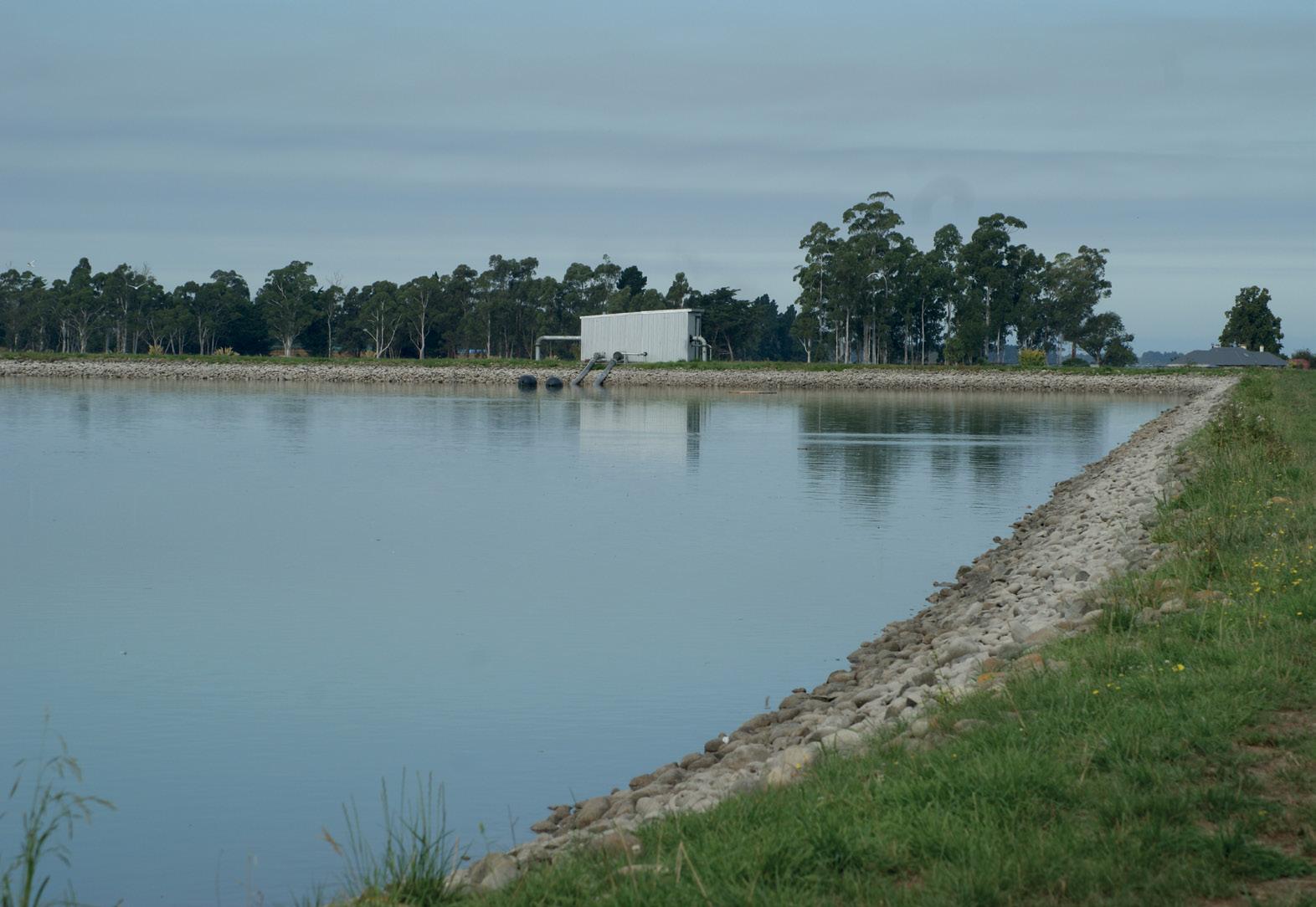
ment approach. The best solution depends on local conditions, water availability, and community needs. Rather than viewing storage options in isolation from one another, we should focus on using the right tool in the right place for the right reasons.
Water storage solutions are typically classified as either on-stream or off-stream, each with distinct advantages.
On-stream storage involves constructing a dam within a river channel, holding back an allocated portion of the water flow from the catchment and allowing the remainder, normally the bulk of the natural flow, to spill back into the stream. This approach efficiently stores large volumes and if capacity is available, can provide flood mitigation benefits. However, careful design is needed to manage sediment movement, fish migration, and naturalised downstream flows.
Off-stream storage involves diverting the allocated water volume from the catchment, normally from a river during a natural high flow period, and storing it for later use in a separate reservoir. While often considered more environmentally acceptable, off-stream storage can be more expensive due to the need for construction limitations, diversions or pumping, and land acquisition.
A well-planned water management strategy incorporates both approaches where appropriate, ensuring water availability while minimising environmental impacts. The choice depends on catchment characteristics,
water availability, land use, and long-term needs. In many cases, a combination of both is the most effective approach.
A common misconception is that smaller water storage solutions are inherently better and that if a project does not impact others externally, it should be allowed to proceed without impediment.
In reality, all reservoirs impact catchment hydrology, meaning that water take and use must always be considered when planning storage type and placement. Smaller reservoirs generally have higher costs per cubic metre of water stored, whereas large-scale reservoirs spread infrastructure costs over greater volumes, potentially making them more economically viable in the long run.
That said, small-scale storage has its place. On-farm ponds support irrigation, frost protection, and stock water supply, while medium-sized localised water harvesting schemes and reservoirs provide resilience for communities. The design of storage –whether created by embankments above ground or excavation below ground –depends on landform, soil conditions, and hydrology.
Rather than focusing on size alone, the goal should be to design storage systems that maximise efficiency, reliability, and long-term benefits. Understanding these cost implications is critical for decision-making – not just for farmers, but also for policymakers and communities looking at long-term water security.

Water storage is often discussed in terms of surface water, but groundwater plays an equally critical role. Instead of seeing surface water and groundwater as separate, we should recognise their natural connectivity and explore ways to incorporate groundwater management.
Managing aquifer recharge may allow excess surface water to be stored underground, potentially improving long-term water availability through controlled extraction. This doesn’t always require artificial or pumped injection – simply slowing down water movement through wetlands, river infiltration basins, or specially designed recharge zones can increase groundwater retention. This approach has been a fundamental aspect of the recently commissioned Waimea Water Storage project in Tasman, which can now augment natural flow in a river that is linked to a groundwater zone over a wide area of multiple uses. By integrating surface and groundwater storage we create a more resilient water supply system that balances short-term needs with long-term sustainability.
Water storage can enhance rather than degrade the environment when designed with care. Large reservoirs and their margins create new aquatic ecosystems that support biodiversity while also offering recreational and community benefits. Constructed wetlands and detention basins improve water quality by filtering sediment and nutrients before they reach rivers. Well-managed retention systems slow floodwaters and allow more controlled water release during periods of naturally occurring low flow.
Storage is not just about securing water for human use – it’s also a tool for maintaining healthy landscapes, mitigating drought impacts, and supporting biodiversity. There are multiple benefits.
Using stored water rather than relying solely on run-of-river sources or aquifers during low-yield periods can be a gamechanger for food production, industrial processes, and the reliability of human drinking
Rather than focusing on size alone, the goal should be to design storage systems that maximise efficiency, reliability, and long-term benefits. Understanding these cost implications is critical for decision-making –not just for farmers, but also for policymakers and communities looking at long-term water security.
water supplies. A multi-use, multi-benefit approach is enabled by water storage. When planned strategically, storage can provide both economic and environmental benefits.
New Zealand needs a practical, well-informed approach to water storage that moves beyond emotional debates. Frankly, some grown-up conversations are well overdue.
Farming and water management are too often framed as environmental problems rather than essential foundations of human existence. We must recognise that all food production – whether for local consumption in New Zealand or contributing to global food security – relies on soil, water, and sunlight. Anyone who has grown food, whether in a backyard garden or at a national scale, understands this fundamental reality.
Rather than demonising storage, we should focus on designing systems that deliver the best outcomes for people and the environment. Large-scale reservoirs will remain crucial for securing long-term water supply, while smaller-scale storage, groundwater recharge, and wetland conservation

each play a role in a diversified water management strategy.
New Zealand is well-placed to balance its abundant water resources with the needs of diverse users while maintaining environmental stewardship. However, achieving this balance requires investment in smart, resilient infrastructure – both grey and green. Water storage – whether in dams, reservoirs, or underground aquifers –provides security against drought, supports food production, and enhances biodiversity when designed well.
The real question is not whether to store water, but how to do it wisely. By taking a strategic, fact-based approach, we can ensure New Zealand meets both its domestic needs and global responsibilities while safeguarding its water resources for future generations.
Adapted from an article for Canterbury Farmer, by Stephen McNally.
Anderson Lloyd is the trusted legal advisor for major players in New Zealand’s irrigation sector, with a proven ability to deliver results.
We have advised on numerous existing and proposed schemes in the North and South Islands and act for individual farmers and agribusinesses.
Our specialist team advises on all aspects associated with large-scale irrigation schemes including banking, capital raising, commercial contract, resource management and construction matters.
David Goodman, Partner p: 03 335 1235 m: 027 787 8785
david.goodman@al.nz
Sarah Eveleigh, Partner p: 03 335 1217 m: 027 204 1479
sarah.eveleigh@al.nz

Tim Cadogan
Local Government Engagement Specialist, Taumata Arowai Former Mayor of Central Otago
When I became mayor of Central Otago District in 2016, I had no idea how much water and water infrastructure would come to dominate my life, and lead to a career change eight years later.
Across the country right now there will be brave folk considering putting their hand up for public office in this year’s local body elections, and they will all have varying backgrounds which allows them to bring different skill sets and understandings to the role, if elected. For me, I came from a legal and broadcasting background. I was heavily invested in my community and felt that I had a lot to offer in terms of community engagement, but my knowledge of water infrastructure was almost zero.
I somewhat recklessly came to the role of mayor without having done time on the council, although I did have two terms of community board experience. On reflection, I was very fortunate to have a group of councillors who were willing to guide me through a steep learning curve rather than jump on my every mistake.
Had I had some council time beforehand, I would have known of the complexity that water issues bring to local government.

Issues around water storage on the Manuherikia River quickly became a dominant issue. The Falls Dam was approaching a hundred years of age, and an ever-changing regulatory environment, economic situation, and community sentiment made the building of a much-needed replacement a significant challenge. This challenge seemed not much closer to being solved after eight years in office than when I started. How much the cost rose in those eight years, and how much more it will rise before any work finally gets under way, will be in the tens of millions of dollars. For that reason alone, a better way of getting major infrastructure projects done simply must be found.
I chaired a working group over my last year in office which tried to progress the project, and I want to note here the invaluable support that IrrigationNZ gave to that group through that time, including, crucially, giving us the opportunity to meet with and learn from others who had travelled the difficult path we were on.
Leaving office without Falls Dam much further progressed is a thing I look back on with a sense of failure from my time as mayor, but water remains the centre of my mahi. The three waters (drinking, waste, and stormwater) account for around 30 percent of Central Otago District Council’s (CODC) budget each year, as they do for many other councils. I took office in October 2016, just two months after the Havelock North water failure occurred. This event made an estimated 5,500 people ill with campylobacteriosis, led to 45 being hospitalised, and may have been associated
with three deaths, all from people using drinking water from a council supply.
The following year, Jim Graham, who is now the water science chief advisor for Water Services Authority – Taumata Arowai, and who I am now fortunate enough to sit next to each day, came to our council and talked through what happened in Havelock North. In the space of an hour, he turned our next Long-Term Plan into a drinking water LTP, with a commitment to bring all eight of the CODC water supplies into compliance within ten years.
The council felt the money that it was going to take to do that was a totally necessary investment in the health of our community. As these costs were extrapolated across all councils, especially when wastewater infrastructure was considered, the challenge facing the country as a whole in the management of all three water types became apparent and led to the then Labour-government’s Three Waters reforms.
These reforms became a dominant subject for mayors and councillors across the country and, when put alongside the Falls Dam situation, I found that water in one form or another was filling a large part of my working day and was a subject about which I needed to rapidly increase my knowledge.
This course of events, totally unexpected when I took office in 2016, has led me to my current role as local government engagement specialist at the Water Services Authority –Taumata Arowai.
Councils supply 84 percent of all drink-
ing water in the country. My role, a newly established one that I took on at the end of October last year, is to actively increase the Authority’s ability to engage with its largest customer base.
And so the cycle repeats itself; when I became mayor I found I needed to rapidly increase my knowledge in the water space, regarding both irrigation and council supply. Now, as I sit amongst the likes of Jim Graham, I find myself yet again needing to rapidly upskill.
That’s the thing with water I guess; it is truly the gift that keeps on giving.
Plans for a water storage facility to support the natural environment and economic prosperity of the Heretaunga Plains, including Napier and Hastings, will move into a full feasibility phase.
Hawke’s Bay Regional Council (HBRC) has confirmed a preferred location for a 27 million cubic metre water storage facility near Whanawhana. The costs of feasibility will be shared with central government.
The proposed reservoir would be located on a small tributary off the Ngaruroro River. Peak winter flows would be stored for release back into the lowland river and stream network during dry summer months, to recharge the aquifer and offset water extraction.
The Ngaruroro catchment contributes to the recharge of the Heretaunga Plains aquifer that supports the region’s horticulture and viticulture industries, and supplies water for Hawke’s Bay’s two main cities, Napier and Hastings, including its households and industries.
The facility would supplement river and lowland stream flows for environmental purposes, enable existing water use which is increasingly constrained, deliver new water to help adapt to a changing climate, and enable growth across the world-class, fertile soils of the Heretaunga Plains. The water would provide for increasing population and housing, new jobs and industries, and a growing, thriving economy.
The facility would increase water security in the context of changing weather patterns. A core commercial principle of the proposal is that any development of a water storage facility would need to be funded by those who benefit most from the stored water.
Chair of HBRC, Hinewai Ormsby, said the future of Hawke’s Bay’s economy depended upon water security, and the ability to access new freshwater supplies. This is becoming a challenge as the climate changes, which presents increasing risk to the people of Hawke’s Bay and its environment and economy.
“As part of our ongoing Water Security Programme, HBRC is focused on how we can better protect our waterways while supporting the future of our economy. There is now a vital role for carefully designed water storage at the right scale and in the right location, and despite the work being impacted by both COVID-19 and the Cyclone Gabrielle recovery, we are now ready for a full feasibility phase for the Whanawhana site.
“Water storage must be one part of a multi-faceted approach, including a constant commitment to maximising efficiency and water conservation. However, this project has the potential to be transformational; unlocking significant productivity gains, improving environmental outcomes, and providing water security for all people of Heretaunga,” she said.
“There is now greater appreciation of the importance of resilience and the role of infrastructure in responding to climate change. Well-developed, responsible water storage projects will need to be part of our
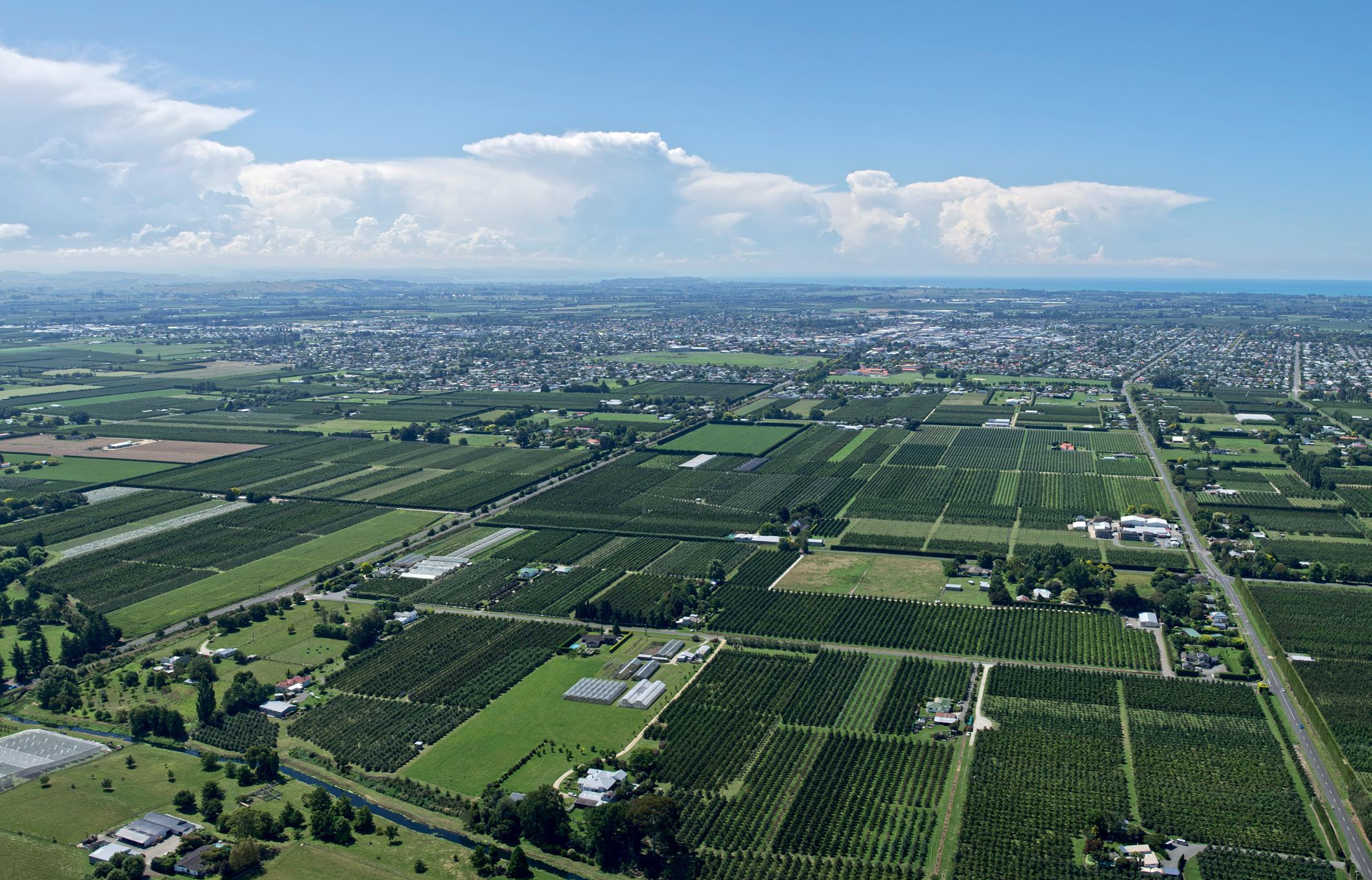
future, alongside continued discipline in demand efficiency and other potential supply initiatives.”
Hinewai Ormsby said the move to full feasibility would see changes in project governance to ensure independence and the use of people with the right commercial skills and experience.
“To ensure a robust feasibility assessment, with a strong focus on commercial viability, we will begin to transition project governance to a new entity.
“The new governance entity will bring together iwi and mana whenua partners, irrigators, representatives of commercial and municipal water users, and community stakeholders to lead the project with a strong development focus.”
Hinewai Ormsby said consultation will occur only when a decision to seek resource consents is made, which would be at the successful conclusion of the feasibility phase.
Mayor of Heretaunga Hastings, Sandra Hazlehurst, said ensuring we have the certainty of water supply is critical for both economic and social wellbeing in Hastings and wider Hawke’s Bay.
“Water is our lifeblood and the key to our future prosperity, both for the growth in municipal supplies for our urban residents and access to rural supplies for our primary industries.
“We know the impacts of a changing climate, bringing both devastating droughts and large rain events like Cyclone Gabrielle. We are excited to understand the opportunity of this new water storage infrastructure project and its contribution to water security for our district’s future.”
A spokesperson for a group of major irrigators on the Heretaunga Plains, Greig Taylor, said water storage for the Heretaunga region was now essential for continued production, to lift productivity, and as an insurance policy for Hawke’s Bay’s economy.
“The Heretaunga Plains are some of the greatest growing soils in the world and the

Water is our lifeblood and the key to our future prosperity, both for the growth in municipal supplies for our urban residents and access to rural supplies for our primary industries.
economic engine of Hawke’s Bay. Water storage is a very important part of a range of solutions we must continue to implement, but the growers of Heretaunga strongly support the development of a local water storage facility to help ensure reliable supply,” said Greig Taylor.
Bayden Barber, Chair of Ngāti Kahungunu Iwi Incorporated, said he supported the feasibility phase.
“It is paramount that mana whenua and Ngāti Kahungunu Iwi is engaged from the outset of any water storage project within our
rohe, kia tika ai ngā mahi hei oranga mō te wai, hei oranga hoki mō ngā whānau.
“We will work with partners in the project to ensure it delivers for our taiao, the health of our awa and the taonga that live within them, and for a thriving, prosperous Māori economy that delivers for our people into the future,” said Bayden Barber.
Acting Mayor of Napier, Annette Brosnan, welcomed further investigations.
“Water security is critical for the future of Napier and its people. We welcome investigations into the development of responsible water storage to support the city of Napier and look forward to the completion of the feasibility phase.”
The feasibility phase of the Heretaunga Water Storage Facility will commence immediately. The feasibility phase is supported with a 2020 loan from the Provincial Growth Fund and is budgeted for in HBRC’s longterm plan.
































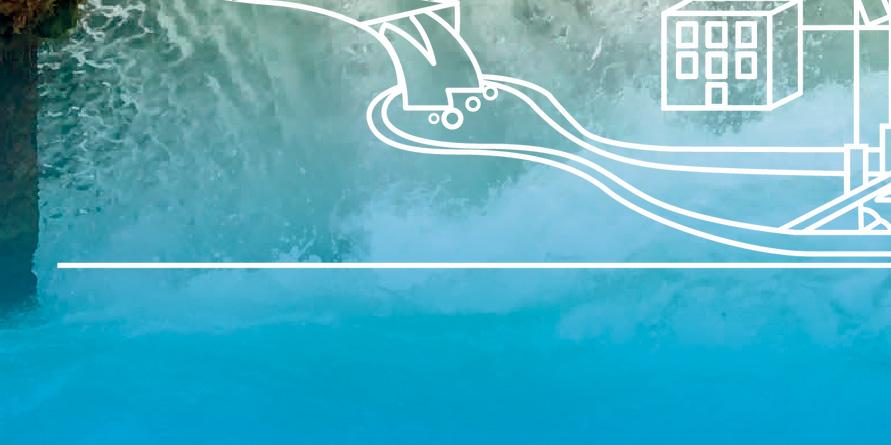


















































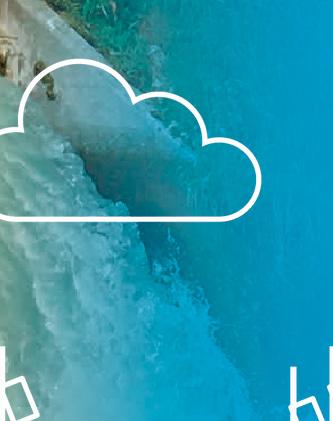



























































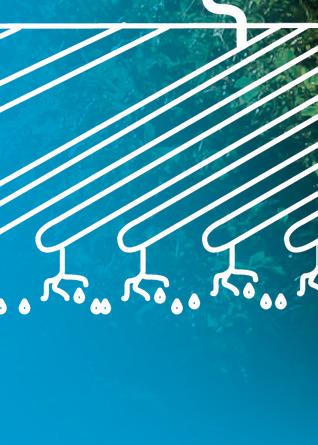














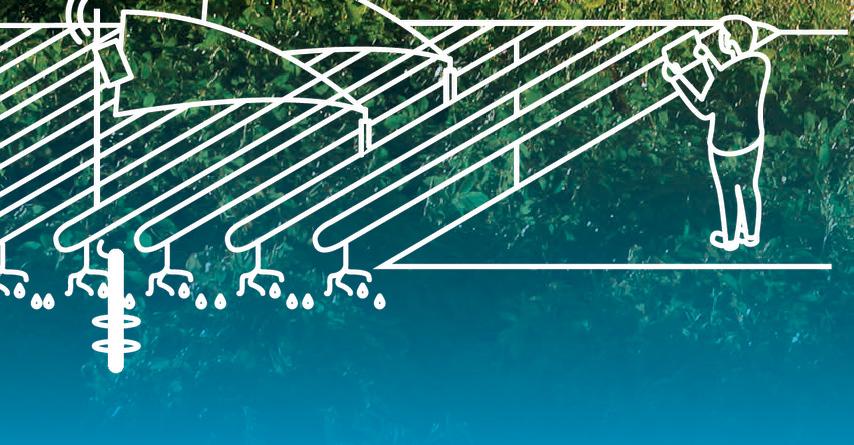























































































Early in February, a Canterbury Regional Council (Environment Canterbury) committee approved a Council submission on the Resource Management (Consenting and Other System Changes) Amendment Bill. Most councillors were largely in favour of the presented submission and agreed for it to be sent after some amendments had been made.
The Bill would amend existing provisions in the Resource Management Act (RMA) relating to infrastructure and energy, housing growth, farming and the primary sector, and natural hazards and emergencies; as well as make system improvements.
In essence, it would fundamentally change how resources are managed in New Zealand – impacting our planning and the way we interact with district and city councils.
The full submission is available on our website. It covers many areas and is too detailed to summarise. However, the following outlines some of the key points:
Support for changes that:
• enable local decision-making
• increase the transparency and efficiency of the consenting process and reduce cost for resource users
• strengthen tools for consenting, compliance and enforcement
• enable adaptive management of discharges where significant adverse effects on aquatic life already exist, provided there will be a reduction in effects over time
• enable councils to write rules that permit discharges where significant adverse effects on aquatic life already exist, providing there are standards in the rule that require a reduction in those effects over time.
Opposition to changes that:
• reduce opportunities for iwi/hapū participation in resource management processes
• give the minister the power to direct a council to change its plans to address non-compliance with a national policy statement
• restrict the types of controls and rules a regional council may use to manage the impacts of fishing activities on marine biodiversity
• enable a review of consent conditions, when those conditions have been contravened by the consent-holder.
Chair Craig Pauling welcomes the opportunity to submit on the proposed RMA reforms.
"A key takeaway from our submission is the importance of local and regional knowledge in decision-making," he said.
"Therefore, it is important to share our views and expertise with Government to help ensure any changes in resource management get the right outcomes for Waitaha/Canterbury.
"Using local expertise and regional relationships often leads to better outcomes for ratepayers. It's important to preserve this."

A focus on efficiency and good irrigation performance will give you a head start as you prepare for next season – supporting compliance and Farm Environment Plan audits.
Bucket testing is part of the good performance equation. With the departure from the market of the CropX bucket testing app, we're now offering information about alternative testing tools.
Check our new page titled 'Irrigation testing tools' on our website ecan.govt.nz for everything you need to know.
As you learnt from IrrigationNZ recently, its new bucket testing tool is likely to come on stream for next season. Watch this space.

We and IrrigationNZ offer plenty of guidance on what good performance looks like. Have a look at the 'Irrigation and water use' section on our website, and the 'Good Management Practice Overview' section on IrrigationNZ's website.
Here are some things you can do to make sure you're ready to irrigate efficiently:
• Plan for the season: if restrictions come in early, be ready to manage your scheduling and identify the higher production areas to concentrate on to get the best return.
• Evaluate your irrigation performance: do bucket testing once a year. This helps determine application depth, rate and how uniformly water is being applied. It may be required as part of your consent conditions and Farm Environment Plan.
• Monitor your soil moisture: one of the most effective ways to improve irrigation efficiency is to implement soil sensor technology in irrigation scheduling.
• Get accurate weather forecast information: weather and evapotranspiration data allow you to take advantage of rain and avoid irrigating when conditions aren't ideal.
• Upskill staff: training on scheduling and operation helps optimise water use and avoid damage to equipment.


It's also important to make sure your irrigator isn't spraying the road. As well as efficiency loss, this can damage the road and is a hazard for motorists. Fines may apply.
In anticipation of your next Farm Environment Plan audit, it's worth revisiting the 'Farm Environment Plans' page on our website to see what they'll be looking for. For example:
• Make sure the irrigation section of your Farm Environment Plan meets the requirements of section 7 of the Canterbury Land & Water Regional Plan, available on our website.
• Use the IrrigationNZ pre-season check templates, which provide a minimum standard. Throughout the season, maintenance will vary from farm to farm, but records should demonstrate a regular maintenance schedule.
• In-season maintenance is vital because, if a system is set up and commissioned properly, one of the common reasons for poor performance is sprinkler malfunction (damage and blockages).
Use the audit checklist on our website.
Note that the CropX bucket test app may still appear in the auditor guidance – this will be corrected if it hasn't already.
We look forward to working with you next season. You can phone our Advisory Services team on 0800 324 636 or email ecinfo@ecan.govt.nz if you have any questions or concerns.
We’re proposing changes to consenting service charges that could impact both users and ratepayers, including:
Increasing the hourly charges for our consent services
Simplifying the way we charge for processing consents
Tell us what you think:
ecan.govt.nz/feesandcharges

It's fair to say there's been some changes and challenges with regulations in recent years. There's a lot going on and it can be frustrating getting your head around it all – we get it.
That's why we want to do what we can to make renewing your consents as stress-free as possible and keep things on the farm ticking over.
If I could give you one piece of crucial advice, it would be to get your consent renewal application in early.
If you lodge your renewal six months before the current consent expires, you can keep operating under your old consent while we're processing the new application.
If you don't lodge your application in time, you might miss out on what's called 'continuance rights', meaning you may not be able to continue the activities covered by your consent while we are working through your new application.
Not having continuation rights can mean real impacts on farm, like your current water allocation, for instance. So, we're encouraging farmers and landowners to get ahead of the game.
If your consent's expiring within the next two years, now's the time to get the ball rolling.
Regulations will have changed since you last applied for your consent. This means you'll probably need to supply more information than before – such as how you'll manage any environmental effects from your activity.
Two years might seem like a long lead-in time, but we want to ensure there's plenty of time for processing – especially if you need technical science reports and/or to consult with other parties.
Our team can help you with your application through our pre-application service. The first hour of this service is free. Additional costs are on the consents page of our website.
Getting advice up front helps things run smoothly, by ensuring the information supplied hits the mark – meaning less back and forth. This helps us process the renewal efficiently and keeps your costs down.
We know it's been a tough and uncertain time for farmers and preparing consent applications is another stress you could do without.
Please do prioritise it though. Consents are like your 'license to operate'. Getting them sorted ultimately means more certainty for your business.
If you have any questions, our Advisory Services team can put you in touch with our duty planner. Phone us on 0800 324 636 or email ecinfo@ecan.govt.nz

Environment Canterbury
Consents Planning Manager Aurora Grant

Stephen McNally Principal Technical Advisor IrrigationNZ
I have long been a supporter of the purpose of New Zealand’s Waterways Centre for Freshwater Management Postgraduate Student Conference. It not only highlights the depth and diversity of freshwater research but also provides an invaluable platform for emerging researchers to refine their ability to communicate complex, yet highly relevant, ideas to a broad audience. The ability to translate technical findings into accessible insights is a critical skill, and this annual event remains a key fixture on my calendar. In comparison to other conferences I have attended, they are well-rehearsed and exceptionally well-organised.
For those unable to attend in person, the Waterways Centre publishes a booklet of abstracts capturing the essence of the New Zealand research presented. With their approval, we have reprinted four abstracts from last November’s Conference that stood out to me – offering a glimpse into the innovative thinking shaping freshwater science today.
Students at 2024 Waterways Centre for Freshwater Management Postgraduate Student Conference.
In future, this conference will take place against the backdrop of a significant national conversation about the future of science funding and organisational structure, following the release of the Science Sector Advisory Group’s (SSAG) recent report. In our submission to SSAG, IrrigationNZ advocated for stronger emphasis on science communication, ensuring that publicly-funded research is not only conducted in a supportive environment but also makes effective communication an imperative, to share findings with those who can benefit
from early adoption.
The Waterways Centre brings together bright minds and diverse skill sets to tackle freshwater challenges across Aotearoa and beyond. Their commitment to applied research on areas from headwaters to estuaries, and their focus on multi-user water systems, river restoration, and policy development, reinforce the need for integrated, forward-thinking approaches to water management.
As we navigate an era of increasing complexity in freshwater issues, initiatives like this conference play a

crucial role in bridging the gap between research and realworld application. I encourage all those in the water sector to engage with the insights emerging from this event –whether in person, through published abstracts like those that follow, or by fostering similar opportunities within their own organisations.
Note, while the event for 2025 has yet to be confirmed, the dates will go on the Waterways Centre website once set – www.waterways.ac.nz


Jack McMecking, Masters Candidate jack.mcmecking@pg.canterbury.ac.nz
Supervisors: Shelly MacDonell, Travis Horton, Bruce Dudley
Mountain catchments can be significant sources of freshwater, and the timing of discharge from mountain catchments has implications for ecological systems, as well as agriculture and industry. However, our understanding of the hydrological processes that occur during, and immediately after, precipitation and snowmelt events is limited. This is in large part because alpine environments experience harsh meteorological conditions that make data collection challenging.
To address this challenge, data collection in cold regions needs to take a multi-method approach and should incorporate data collected in situ (by field workers and autonomously), and remotely. Autonomous sampling enables data to be collected in storms or during other adverse conditions, as data or samples can be subsequently collected when the weather conditions are more suitable.
The overall aim of this study is to understand the connection between storm events and hydrological response in a small mountain catchment. More generally, we seek to understand how hydrological processes controlling streamflow change during and after different types of precipitation events.
Using Camp Stream as a case study, this study examines temporal patterns of discharge sources across a winter-to-summer melt season; we compare the isotopic composition and water quality of Camp Stream at a high temporal resolution with the various inputs to the stream system including precipitation during different types of storms and other flow pathways.
ABSTRACT 2:
USE OF REMOTE SENSING AND LAKE WATER BALANCE ANALYSIS TO IMPROVE PREDICTIONS OF FLOW AND SEDIMENT IN THE LAKE OPUHA CATCHMENT
Maria E Borges Brinceno, PHD Candidate maria.borgesbriceno@pg.canterbury.ac.nz
Supervisors: Tom Cochrane, Markus Pahlow, Arman Haddadchi
Lake Opuha in New Zealand is a source of irrigation water for nearby agricultural land. However, poor water quality caused by excessive suspended sediment affects its ability to meet irrigation demands. Therefore, developing a lake water balance model, together with catchment flow and sediment modelling, is necessary to better understand both the temporal and spatial sources of sediment and address current and future suspended sediment problems.
Research is thus needed to address these objectives: (1) model sediment spatially and temporally, (2) use remote sensing products to improve the accuracy of input data, and (3) create a water balance model of the lake. The Soil and Water Assessment Tool (SWAT+) was selected to model sediment dynamics in the Lake Opuha catchment. Specific methodology involves: (1) using Sentinel-2 satellite imagery to improve the land cover map and detect land movements that could contribute to increased sediment yield, (2) sampling suspended sediment from the tributaries and the lake to identify

sediment sources, (3) monitoring lake levels and tributary flows, and (4) performing a water balance of the lake to obtain accurate peak flows.
Initial model calibration is being carried out using flow data and future work will include calibration using sediment data. The inclusion of sediment sources and the water balance approach are expected to improve the model’s ability to simulate sediment dynamics and hydrological processes, enabling better scenario modelling and solutions.
Sidinei Teixeira, Masters Candidate sidineihutana@gmail.com
Supervisors: Peter Almond, Naomi Wellis, Brett Painter, Matt Dodson, Justin Legg
Nitrate leaching is a significant problem in agricultural ecosystems, threatening water quality, human health, and biodiversity. Managed Aquifer Recharge (MAR) has potential to address elevated nitrate levels in alluvial aquifers. However, the effectiveness of MAR in nitrate dilution is not fully understood.
This study employs a novel statistical approach to analyze factors driving shifts in nitrate concentrations within alluvial aquifers, emphasizing irrigation practices and MAR. A total of 30 groundwater wells and 12 surface water sites, including major rivers, springs, and irrigation channels, were sampled monthly over a five-month period in the Hekeao/Hinds catchment. Chemical analyses, including isotopic signatures for dual water isotopes and major ion concentrations, were utilised within a Bayesian mixing model, to quantify sources recharging the aquifers.
The study also examined the relationship between groundwater nitrate concentrations and irrigation water quality, identifying additional influential factors. Results indicated that MAR significantly enhanced nitrate dilution up to 1.5 km downstream from a large MAR site, contributing up to 52 percent of groundwater recharge and reducing nitrate concentrations to acceptable levels. Conversely, in other regions, the volume of MAR-influenced water was inadequate to mitigate extensive nitrate plumes.
This research presents a transferable methodology for quantifying
pollutant inputs in similarly modified catchments. It enhances our understanding of nitrate dynamics in alluvial aquifers and highlights MAR’s potential and limitations as a viable solution for mitigating nitrate pollution, offering critical insights for policymakers and practitioners dedicated to limiting groundwater degradation in agricultural landscapes.
Aimee Calkin, MWRM aimee.calkin@wsp.com
Supervisors: Ann Brower, Shelley MacDonell
This research examines the issue of land use change in and around Aotearoa New Zealand’s braided rivers between 1990 and 2020. It develops and tests a method to ask: whether and how land use changed in and around New Zealand’s braided rivers; and whether there are geographic patterns in the land use change?
The analysis of this research finds land use has changed across New Zealand’s braided rivers and has changed the most in Canterbury of the South Island and in rivers with more gravel area. Land use has changed the least across the North Island’s regions and Southland. The rivers in these latter areas have a reduced gravel content compared to Canterbury rivers. This research concludes by looking into the future of legislative change to the definition of braided rivers in Aotearoa New Zealand.
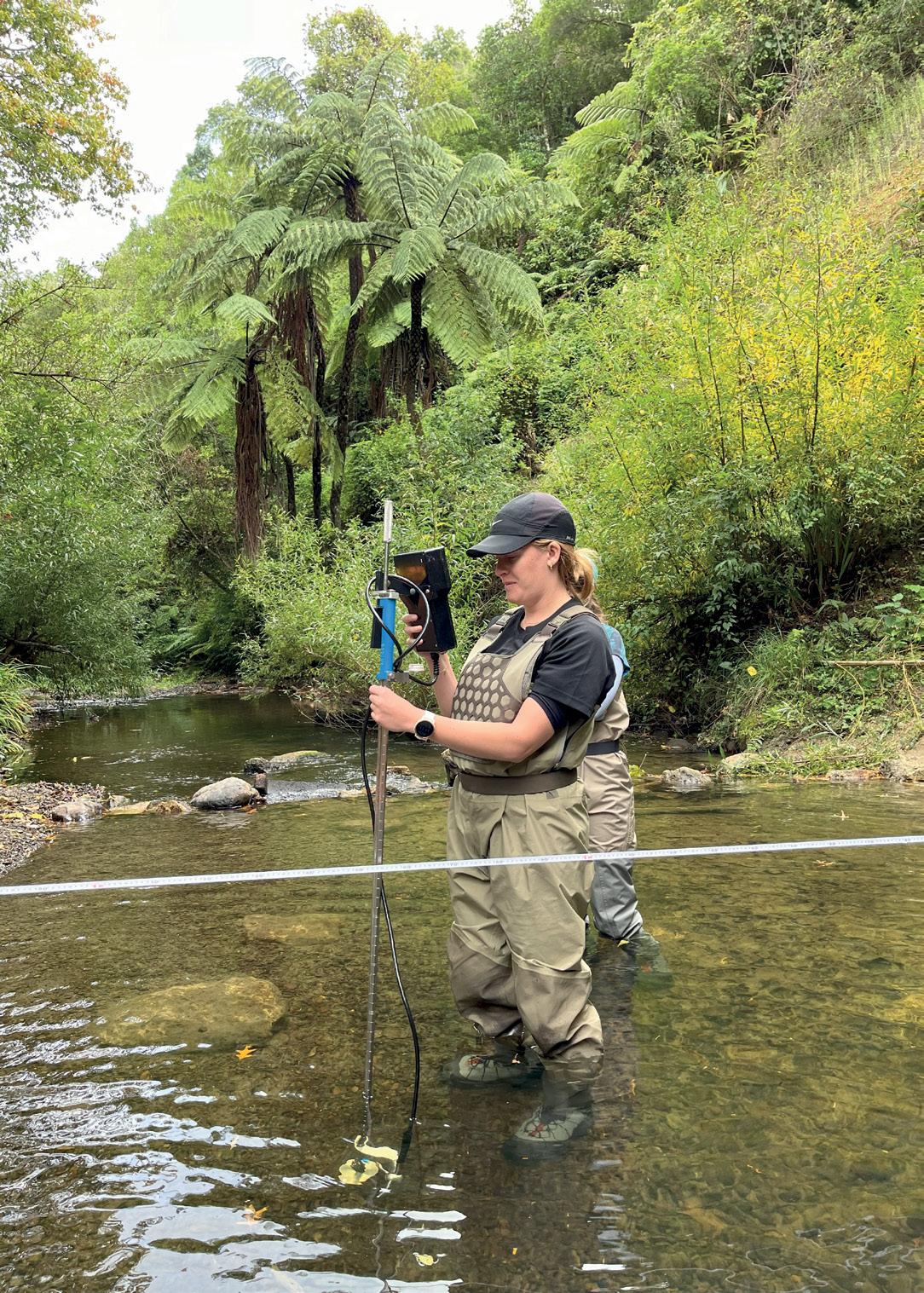

















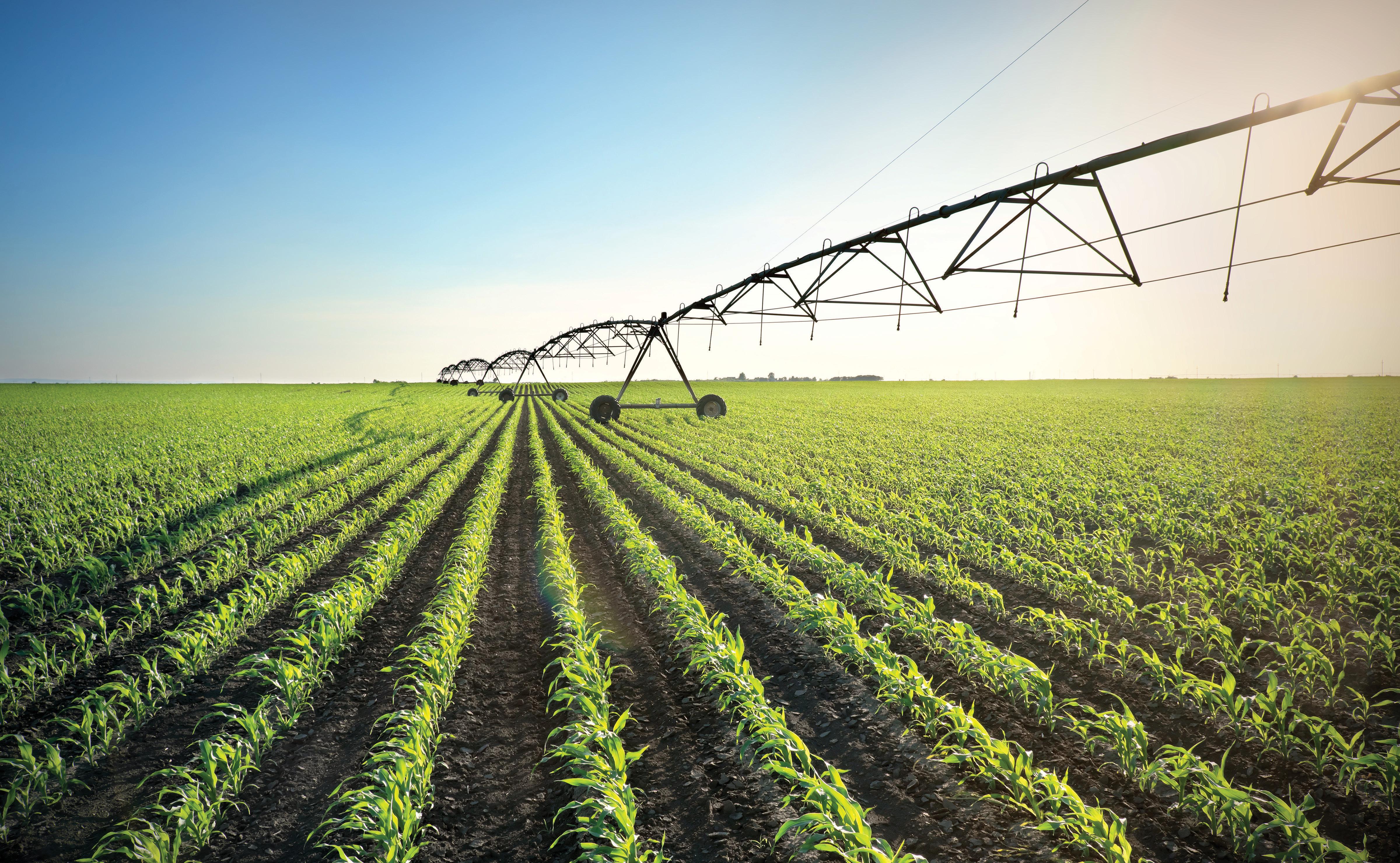


































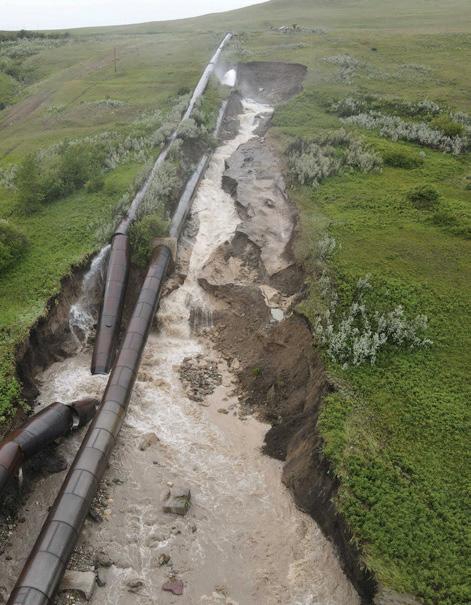


Stephen McNally Principal Technical Advisor IrrigationNZ
Water storage remains a critical issue on the political agenda, offering significant opportunities to enhance resilience against climate variability, safeguard food security, and support rural communities. As climate change accelerates, the need for sustainable water management solutions has never been greater. IrrigationNZ continues to work closely with policymakers, industry stakeholders, and local authorities to advocate for strategic investment in water storage infrastructure.
A well-developed water storage strategy is key to improving land productivity, ensuring consistent water supply, and mitigating the economic impacts of droughts. We are actively pushing for streamlined consent processes and practical funding models to help our members navigate the complexities of implementing storage solutions efficiently and affordably. By reducing bureaucratic barriers and increasing financial accessibility, we can enable more farmers and growers to adopt robust water storage systems that serve both immediate and longterm needs.
The urgency of investment in water storage is underscored by the increasing frequency and severity of droughts, which have had devastating impacts on agricultural productivity and regional economies. Without reliable water storage infrastructure, farmers are left vulnerable to the erratic nature of seasonal rainfall patterns. Large-scale storage projects,
combined with efficient distribution networks, are essential for stabilising water availability, reducing dependency on groundwater sources, and ensuring resilience for future generations.
Improved water storage infrastructure enables farms to continue to irrigate during periods when their normal water supplies (rivers and groundwater bores) are restricted. This means an overall increase in agricultural productivity compared with farms that have no water storage, particularly in drought-
prone regions. This is achieved through better water availability during dry periods, allowing for more consistent irrigation schedules and improved crop yields. By integrating modern irrigation technologies with advanced storage solutions, the agricultural sector can not only adapt to climate challenges but also sustain food production at levels necessary to meet growing domestic and international demands. IrrigationNZ is committed to promoting policy frameworks that support these objectives. We are engaging with government

agencies to explore funding mechanisms that can accelerate the development of new water storage projects. Additionally, we are advocating for the adoption of innovative water management practices that enhance the efficiency and sustainability of existing infrastructure.
The path forward requires a collaborative effort among farmers, industry leaders, and policymakers. We encourage all stakeholders to participate in discussions and contribute to shaping policies that will ensure a resilient water future for New Zealand. Through coordinated efforts, we can unlock the full potential of water storage solutions and secure long-term sustainability for our agricultural sector.
With summer weather in full swing, ensuring optimal irrigation performance remains a top priority. Even though January was wetter than expected in some areas, the need for efficient water management is as pressing as ever. The recurring nationwide issue of underperforming irrigation systems continues to hinder agricultural productivity, highlighting the importance of proactive oversight and maintenance.
Periods of hot weather are not the time for complacency. Parched pastures and inefficient water use serve as stark reminders of the consequences of poor irrigation management. Even the most well-designed and well-maintained irrigation systems require continuous monitoring and adjustments to
IrrigationNZ is also advocating for policies that support the widespread adoption of advanced irrigation technologies. By working with policymakers and industry leaders, we aim to promote the ways in which farmers who invest in sustainable irrigation solutions will benefit.
perform at peak efficiency. While SCADA (Supervisory Control and Data Acquisition) systems provide advanced monitoring capabilities, physical inspections remain invaluable for identifying issues that automated systems may overlook.
Farmers must take a hands-on approach to irrigation management to maximise the effectiveness of their systems. Investing in soil moisture sensors, conducting regular equipment checks, and ensuring proper nozzle calibration can significantly enhance efficiency. Irrigation systems that are not properly maintained not only waste valuable water resources but also lead to reduced crop yields and increased operational costs. In a time of growing environmental concerns and economic pressures, maximising irrigation efficiency is both a practical necessity and an ethical responsibility.
To support farmers in optimising their irrigation performance, IrrigationNZ is offering a range of practical tools and educational resources. Our technical workshops and online materials provide guidance on finetuning irrigation equipment, reducing water waste, and implementing best practices to achieve higher productivity. By participating in these programmes, irrigators can gain valuable insights and skills that will help them improve water use efficiency and enhance overall farm profitability.
Case studies from farms across New Zealand demonstrate the significant benefits of adopting smart irrigation management systems. Data shows that farms utilising precision irrigation techniques and realtime monitoring tools have achieved up to
a 15 percent reduction in water use while maintaining, or even increasing, crop yields. These findings reinforce the value of investing in modern irrigation technologies and highlight the need for ongoing education and training in best management practices.
IrrigationNZ is also advocating for policies that support the widespread adoption of advanced irrigation technologies. By working with policymakers and industry leaders, we aim to promote the ways in which farmers who invest in sustainable irrigation solutions will benefit. Additionally, we are collaborating with researchers and technology providers to develop innovative approaches that further enhance water use efficiency in the agricultural sector.
Looking ahead, it is essential that we continue to prioritise irrigation performance improvements. By embracing technology, conducting regular system assessments, and actively participating in knowledge-sharing initiatives, we can ensure that New Zealand’s agricultural sector remains competitive, resilient, and sustainable.
In conclusion, our advocacy efforts in water storage and irrigation performance are driven by the need to secure the future of farming in New Zealand. By addressing these critical issues head-on and working collaboratively with stakeholders, we can build a more resilient and productive agricultural landscape. We encourage all members to stay engaged, take advantage of available resources, and contribute to shaping policies that will safeguard our water resources for generations to come.

The current review of the education system presents a crucial opportunity to reshape vocational training, ensuring that it better meets the evolving needs of the primary sector. As the agricultural landscape shifts due to technological advancements, climate change, and policy reforms, it is essential that professionals working in irrigation and water management have access to training programmes that are both relevant and effective. IrrigationNZ is playing an active role in collaborating with training providers to develop industry-led solutions aimed at equipping professionals with the necessary skills to excel in their roles.
One of the key areas of focus is establishing qualifications that are fit-for-purpose and accessible to those currently working in the industry. The traditional model of vocational education has often been constrained by outdated frameworks that fail to address the practical demands of the sector. This has created a disconnect between education providers and industry needs, leading to skill shortages and inefficiencies in workforce development. By working closely with policymakers, educators, and industry stakeholders, we aim to create a streamlined pathway that ensures irrigation professionals receive both the technical knowledge and practical experience required to succeed in a rapidly evolving environment.
A significant component of this initiative is the inclusion of irrigation-focused modules within existing agricultural qualifications. Many current programmes lack dedicated training in water management, despite the critical role irrigation plays in sustainable agriculture. By integrating irrigation best practices into agricultural courses, we can ensure that future generations of farmers and water managers develop a strong understanding of efficient water use, sustainability, and regulatory compliance from the outset of their careers.
In addition to curriculum development, IrrigationNZ advocates for training programmes that provide hands-on learning experiences, such as apprenticeships, industry placements, and field-based training sessions. These approaches allow trainees to develop practical skills while working directly with irrigation systems, gaining exposure
to real-world challenges and solutions. Such immersive training ensures that graduates are well-prepared to apply their knowledge in professional settings.
Beyond initial training, continuous professional development is another area that requires attention. Given the rapid pace of technological advancements in irrigation systems, ongoing education is essential for professionals to stay updated with the latest innovations, regulations, and best practices. Establishing professional certification programmes and refresher courses can help maintain high industry standards while fostering a culture of lifelong learning within the sector.
The education system must evolve to support the primary sector with focused entities that understand our needs. By eliminating bureaucratic barriers and fostering closer collaboration between industry and educational institutions, we can create a more dynamic, responsive, and effective training framework. A well-trained workforce is essential for ensuring the sustainability and efficiency of irrigation systems, ultimately contributing to increased food security, environmental stewardship, and economic resilience.
The Resource Management Act (RMA) plays a critical role in governing land and water use in New Zealand. However, over the years, the regulatory framework has become increasingly complex, often resulting in inefficiencies, delays, and uncertainty for water users. IrrigationNZ supports efforts to modernise the RMA to create a more efficient and balanced approach to managing land and water resources.
Our vision for RMA reform includes the following key priorities:
• Recognition of irrigation’s role in food security and land productivity Irrigation is fundamental to New Zealand’s agricultural sector, supporting food production and economic growth. Any reforms to the RMA must acknowledge the essential role irrigation plays in ensuring reliable food supply and maintaining productive farmland. Without a clear recognition of this importance, regulatory uncertainty could hinder investments in water infrastructure
and limit the sector’s ability to adapt to changing conditions.
• Creating certainty for water users Farmers and irrigation schemes require long-term planning security to make informed investment decisions. The current regulatory uncertainty surrounding water consents and resource allocations poses a significant challenge to sustainable development. We advocate for reforms that provide greater clarity and consistency in water management regulations, ensuring that water users can operate with confidence.
• Balanced framework considering environmental, economic, and social factors
Sustainable water management requires a holistic approach that balances environmental protection with economic and social considerations. The current RMA processes often result in prolonged consent applications and regulatory bottlenecks, which can stifle innovation and efficiency. By streamlining approval processes and adopting a more pragmatic approach to environmental regulation, we can achieve better outcomes for all stakeholders.
• Supporting water storage and distribution infrastructure
One of the most pressing challenges facing the irrigation sector is the need for improved water storage and distribution systems. Climate variability and changing weather patterns have increased the frequency of droughts, making it essential to develop resilient water infrastructure. RMA reforms should support investment in water storage solutions, ensuring that farmers and communities have access to reliable water sources during dry periods.
To advance these objectives, we are working closely with government officials and policymakers on key amendments to the RMA. One of the specific areas we are focused on is clarifying Section 70, which deals with discharge consents. Current interpretations of this section often lead to excessive bureaucratic hurdles that delay or prevent essential infrastructure projects. By advocating for pragmatic solutions, we aim to ensure that industry-led farm plan certification processes are recognised as valid compliance mechanisms.
In our recent recommendations to the
Select Committee, we proposed several key changes, including:
• Clear definitions for infrastructure Regulatory uncertainty surrounding infrastructure definitions has been a significant barrier to progress. By establishing clear and precise definitions we can reduce ambiguity and ensure that irrigation projects are assessed consistently under the law.
• Long-term consent security for large-scale projects
Irrigation infrastructure represents a substantial long-term investment. Uncertainty around consent renewals and regulatory changes can deter investment in large-scale projects. We are advocating for reforms that provide greater security and stability for long-term water management initiatives.
• Holistic natural hazard planning
Climate resilience must be integrated into regulatory frameworks. We propose a more proactive approach to natural hazard planning that supports rural resilience and ensures that food production can continue even in the face of extreme weather events.
These recommendations are crucial in preventing regulatory bottlenecks that could hinder infrastructure development. Irrigation is a long-term investment, and ensuring stability in the regulatory environment is critical to encouraging innovation and sustainable growth. A well-structured RMA will not only facilitate better land and water management but also strengthen the resilience of New Zealand’s primary sector.
Additionally, we recognise the importance of integrating Māori perspectives into water management decisions. Collaborative governance models that involve iwi and hapū can lead to more sustainable and equitable water management outcomes. The recognition of indigenous water rights is an essential step towards building a more inclusive and future-focused framework for irrigation in New Zealand. By fostering partnerships and engaging in meaningful dialogue with Māori stakeholders, we can create water management strategies that benefit all communities while respecting cultural values and historical water rights.
Both education reform and RMA modernisation present significant opportunities to strengthen the irrigation sector and enhance
New Zealand’s approach to water management. By developing industry-led training programmes, we can ensure that professionals in irrigation and water management are well-equipped with the skills and knowledge required for sustainable agriculture. Simultaneously, by advocating for RMA reforms that provide clarity, stability, and support for infrastructure development, we can create a regulatory environment that fosters long-term investment and resilience.
IrrigationNZ remains committed to working alongside government agencies, industry stakeholders, and Māori communities to drive positive change in these areas. With a collaborative and forward-thinking approach, we can build a more sustainable, efficient, and productive future for irrigation and water management in New Zealand.
Many small rural water schemes provide both irrigation and drinking water, creating unique regulatory challenges. Unlike urban water systems, these mixed-use schemes must balance the needs of agricultural productivity with the provision of safe drinking water for communities. As the regulatory landscape evolves, it is crucial to ensure that compliance requirements remain practical, achievable, and tailored to the realities of rural water supply.
IrrigationNZ is actively working with stakeholders, including water suppliers, regulatory bodies, and local communities, to ensure that compliance pathways remain feasible. We advocate for a regulatory approach that recognises the distinct nature of mixed-use water schemes and supports their continued viability without imposing excessive financial or administrative burdens.
IrrigationNZ is actively working with stakeholders, including water suppliers, regulatory bodies, and local communities, to ensure that compliance pathways remain feasible.
Our recommendations on the Water Services Bill reflect our commitment to a balanced and pragmatic approach:
• Proportional compliance requirements
Recognising the operational and financial constraints of rural schemes, compliance measures should be scaled appropriately to ensure they remain achievable for smaller operators.
• Improved risk management tools
Effective monitoring systems, such as enhanced E. coli testing protocols, can help mitigate risks while reducing unnecessary costs for suppliers.
• Greater collaboration between Taumata Arowai and water suppliers
A cooperative approach will lead to more effective regulatory implementation and ensure water safety without disrupting irrigation operations.
By advocating for these measures, we aim to help members comply with regulations while maintaining efficient irrigation networks. The proposed amendments to the Water Services Act 2021 acknowledge the challenges faced by mixed-use rural water suppliers. Through constructive engagement, we are working to ensure that regulatory frameworks support sustainable rural water management and do not impose disproportionate costs on rural communities.
As the Ministry of Business, Innovation and Employment’s new Dam Safety Regulations come into effect, many dam owners are navigating compliance for the first time. The introduction of formal asset management requirements represents a significant shift, particularly for smaller operators who may not have previously engaged in structured compliance processes. IrrigationNZ is committed to guiding members through these changes, providing the necessary support and technical resources to simplify the process and ensure compliance is both achievable and cost-effective.
One of the key challenges is the issue of asset management ownership and responsibility. Many of the dams affected by the regulations have existed for decades with minimal oversight, making it difficult to establish clear
accountability for maintenance and safety compliance. To address this, we are:
• providing technical guidance to help members understand their responsibilities
• advocating for practical implementation strategies that acknowledge the diversity of dam structures and their usage
• supporting members with risk assessment tools to ensure compliance without excessive cost or complexity.
Our goal is to facilitate a smooth transition into compliance, minimising disruptions while ensuring that water storage infrastructure remains safe and reliable for both agricultural and community needs.
The Government’s restructuring of Crown Research Institutes (CRIs) into Public Research Organisations (PROs) presents both challenges and opportunities for the irrigation sector. This transition offers the potential for increased collaboration and innovation, ensuring that agricultural and environmental research remain at the forefront of national priorities.
IrrigationNZ is actively engaged in this process, advocating for continued investment in research areas critical to irrigation, such as:
• Water use efficiency
Developing new technologies and best practices to optimise water allocation and minimise waste.
• Climate resilience
Researching strategies to help farmers and irrigators adapt to changing weather patterns and water availability.
• Irrigation technology advancement Encouraging the development of AI-driven irrigation management systems and other cutting-edge innovations.
By ensuring that research efforts align with industry needs, we can drive long-term growth and sustainability for New Zealand’s irrigation sector. Our involvement in these discussions helps position the industry for future success while maintaining a strong focus on environmental stewardship.
Engaging with members and stakeholders is essential to the success of our advocacy and research efforts. Last year, IrrigationNZ participated in the Kai anamata mō Aotearoa (KAMA) research programme workshop, contributing valuable insights into the future of sustainable nutrition research. The workshop provided a platform to discuss the intersection of irrigation, food production, and environmental sustainability.
The researchers are due to report back to the workshop participants on progress against the research goals, and set out opportunities for future participation to further strengthen industry collaboration. This information aims to:
• validate key insights from the workshop
• identify additional research opportunities
• strengthen industry collaboration for sustainable irrigation practices.
Our input will help shape the direction of future research initiatives and industry strategies.
To support continuous learning and best practices in irrigation soil moisture management, we are finalising essential technical resources designed to enhance knowledge and capability within the sector. These include:
• Book 11: Soil Moisture Monitoring Revising and updating the previous comprehensive guide to understanding and optimising soil moisture levels for improved irrigation efficiency.
• Soil Moisture Monitoring (SMM) Equipment Selection Guide
A resource dedicated to assisting farmers with selecting the correct soil moisture monitoring techniques and technologies.
These guides will serve as valuable tools for irrigation professionals, helping them improve water management, optimise system performance, and stay up-to-date with industry advancements.
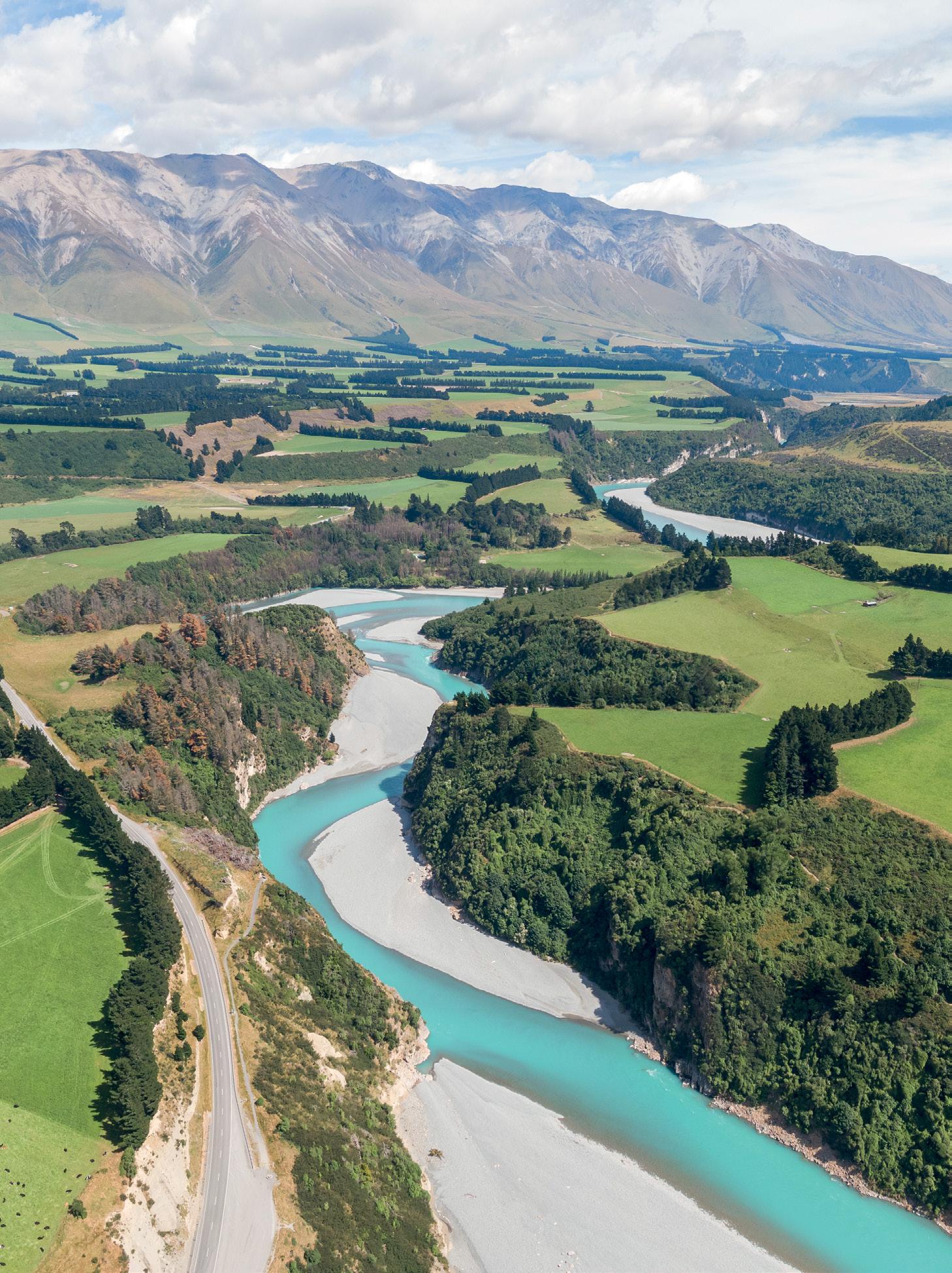
As always, we continue to evaluate emerging challenges and opportunities in irrigation and water management. Some key areas of focus include:
• assessing current farm system monitoring techniques to ensure that irrigation strategies align with evolving agricultural practices
• identifying potential risks such as disruptions to cellular communication networks, which could impact automated irrigation systems
• exploring technological advancements including AI-driven irrigation management solutions that can enhance precision and efficiency.
IrrigationNZ remains dedicated to supporting members through advocacy, education, and technical expertise. By collaborating with regulatory bodies, research organisations, and industry stakeholders, we can drive positive change and secure a strong future for irrigation in New Zealand.
We encourage all members to stay engaged, leverage available resources, and contribute to ongoing discussions. By working together, we can ensure that New Zealand’s irrigation sector remains innovative, sustainable, and resilient for generations to come.
At IrrigationNZ we know that great irrigation relies on great people – people with the right skills, knowledge, and experience to deliver efficient, sustainable systems. As the demand for expertise grows, so does the need to build capability across our industry.
That’s why we’re calling on you to take part –whether it’s by signing up for one of our NZQA-recognised qualifications or by helping us improve training for everyone in the sector.

Help us make training even better
Now more than ever, work-based training is under the spotlight, and we want to ensure irrigation has a strong, practical, and future-ready voice at the table.
We’re looking for industry voices to help shape the future of irrigation training in New Zealand. We’d love to hear from you if you’re keen to volunteer to:
• review existing qualifications or help develop new ones
• contribute to career pathway and skills mapping for the sector
• share ideas for entry-level training
• address ways to attract new people to the industry, or
• take part in interviews, surveys, or working groups focused on improving training.
Your knowledge and expertise are valued by the irrigation sector. Whether you have lots of time to give or just want to contribute in small ways, your input could make a big difference.
We currently have places available in our specialist training programmes, both designed to give you the practical tools and technical know-how to step up your career and support better irrigation outcomes.
Do you want to help your clients optimise performance and meet Good Management Practice standards? This 7-month course is built for people working in the field who want to carry out full irrigation system performance evaluations and provide real value to clients through detailed appraisal and reporting.
What you’ll learn:
• How to assess the performance of multiple irrigation system types
• How to use evaluation data to identify issues and recommend improvements
• How to better support clients with farm plan compliance
Course snapshot:
• Duration: 7 months – including 3 days of in-person training
• Assignments: 2 full system evaluations
• Next intake: Expressions of interest for 2025 open now www.irrigationnz.co.nz/ EventsAndTraining/Irrigators/CPA
If you already have some irrigation experience and want to take your design skills to the next level, this course is for you. Over 16 months, you’ll learn how to design efficient, fit-forpurpose irrigation systems, work through real-world projects, and build a portfolio of evidence you can use in the field.
What you’ll learn:
• How to work with clients to assess their property’s irrigation needs
• How to analyse soil moisture, water consents, and climate data
• How to design, plan, and document the installation of irrigation systems
• How to prepare professional design reports, contracts, and operation manuals
Course snapshot:
• Duration: 16 months – including 9 days of in-person training
• Assignments: 4 – including 2 full system designs
• Next intake: May 2025 – Only 2 spaces left available at time of publication www.irrigationnz.co.nz/EventsAndTraining/ Irrigators/CID
Feedback from student of New Zealand Certificate in Irrigation System Design, 2024
“The course has provided a strong foundation of theory to support my practical knowledge. This has made me a more confident irrigation designer; able to back up my decisions with solid technical understanding. I would highly recommend the course for professional development. In addition to the core principles of irrigation design, the course also offers valuable insights into contract and project management –essential skills for successfully managing irrigation projects.”

To sign up for a course or get involved as a volunteer, please contact Julie Melhopt at jmelhopt@irrigationnz.co.nz.

Whether you are new to irrigation or have experience in the sector, this course will equip you with up-to-date safety knowledge and skills that are tailored to our sector.
The Foundation Passport – Civil (Irrigation) course is the result of collaborative efforts between IrrigationNZ and Site Safe, featuring targeted content and information catered to the unique needs of the irrigation industry.
This course serves as a valuable platform for renewing or issuing a Site Safety Card, offering an industry-specific alternative to other Site Safe Foundation Passport courses. Geared towards various individuals within the New Zealand irrigation sector, the course accommodates workers, young workers, apprentices, secondary school students aspiring to enter the sector, career changers into the sector, and migrant workers, whether or not they have international irrigation work experience.
Designed as a comprehensive four-hour program, the Foundation Passport – Civil (Irrigation) course introduces learners to vital topics such as maintaining personal health and safety onsite. Participants will gain insights into identifying common hazards and critical risks, along with learning how to apply appropriate controls. Understanding the roles and legal responsibilities of both workers and employers will be covered, emphasising the promotion of good mental health and overall well-being.
Prioritising health and safety in the irrigation sector is not just a regulatory requirement but a commitment to fostering a secure working environment for all stakeholders. The recent Maritime NZ v Gibson judgment has put an even bigger spotlight on employer responsibilities for employee safety.
We invite you to participate in one of these upcoming courses:
• May 2nd – Ashburton
• June 9th – Christchurch
• September 19th – Ashburton

For more information and to register, scan the QR code or visit the course information page on IrrigationNZ’s website: www.irrigationnz.co.nz/ EventsAndTraining/Irrigators/FPI



Designing or upgrading your irrigation or effluent system? Using an accredited company means your irrigation infrastructure and practice will be efficient, targeted and sustainable.
With more emphasis on irrigation efficiency than ever before, choosing an accredited Irrigation Design company is an easy way to ensure that the irrigation system you install today meets both regulatory and industry performance benchmarks. Accredited Irrigation Design companies have industry trained professionals and excellent product knowledge to ensure that every drop counts.
Dairy farm effluent was once considered a waste product, now a reliable source of nutrient that enables dairy farmers to reduce their overall nutrient costs.
Farm Dairy Effluent Design accredited companies have the expertise to design and build a dairy effluent system that meets the expectations of regional rules throughout New Zealand.
Councils are aiming for national consistency in water metering, measurement and the reporting of water use data.
Engaging ‘blue tick’ accredited companies will help ensure work is in line with manufacturers’ specifications, meets industry best practice, and ensures accuracy in the reporting of data back to councils for future decision making.
In February 2025, oceanic and atmospheric conditions remained broadly consistent with a weak La Niña.
The ocean and the atmosphere in the tropical Pacific are not strongly nor consistently coupled, contributing to the general weakness of this event and some of its unusual characteristics.
La Niña-like signals in both the ocean and the atmosphere have weakened significantly very recently.
International guidance indicates about a 65% chance for the tropical Pacific to transition to ENSO-neutral conditions during March–May 2025.
Overall, a mix of anticyclonic flows and easterly quarter flows are expected over New Zealand over the autumn season.
Seasonal air temperatures are expected to be above average for the north and west of both Islands, with about equal chances for near average or above average seasonal temperatures for the east of the North Island and the east of the South Island. However, as the season progresses, the threat of frosts will increase.
Autumn rainfall totals, as a whole, are expected to be near normal or below normal for the west of the North Island and the west of the South Island, near normal for the north of the North Island and north of the South Island, and near normal or above normal rainfall in the east of both islands. Unusual dry spells can be expected at times, especially early in the forecast period. Subseasonal projections of rainfall and dryness are updated daily through the NIWA35 forecast.
Late summer through early autumn is the peak of the tropical cyclone season. The risk for an ex-tropical cyclone to pass within 550km of New Zealand is normal-toelevated through April.
Ocean waters remain much warmer than average around the South Island, with extended areas offshore as well as Cook Strait experiencing marine heatwave (MHW) conditions. Global climate forecasts show Sea Surface Temperatures (SSTs) remaining above average in particular around the South Island over the next three months.
NIWA’s SST update will continue to track this situation.
March–May 2025 soil moisture levels and river flows are about equally likely to be near normal or below normal in all regions of New Zealand, except for the east of the South Island, where near normal soil moisture levels and river flows are likely.
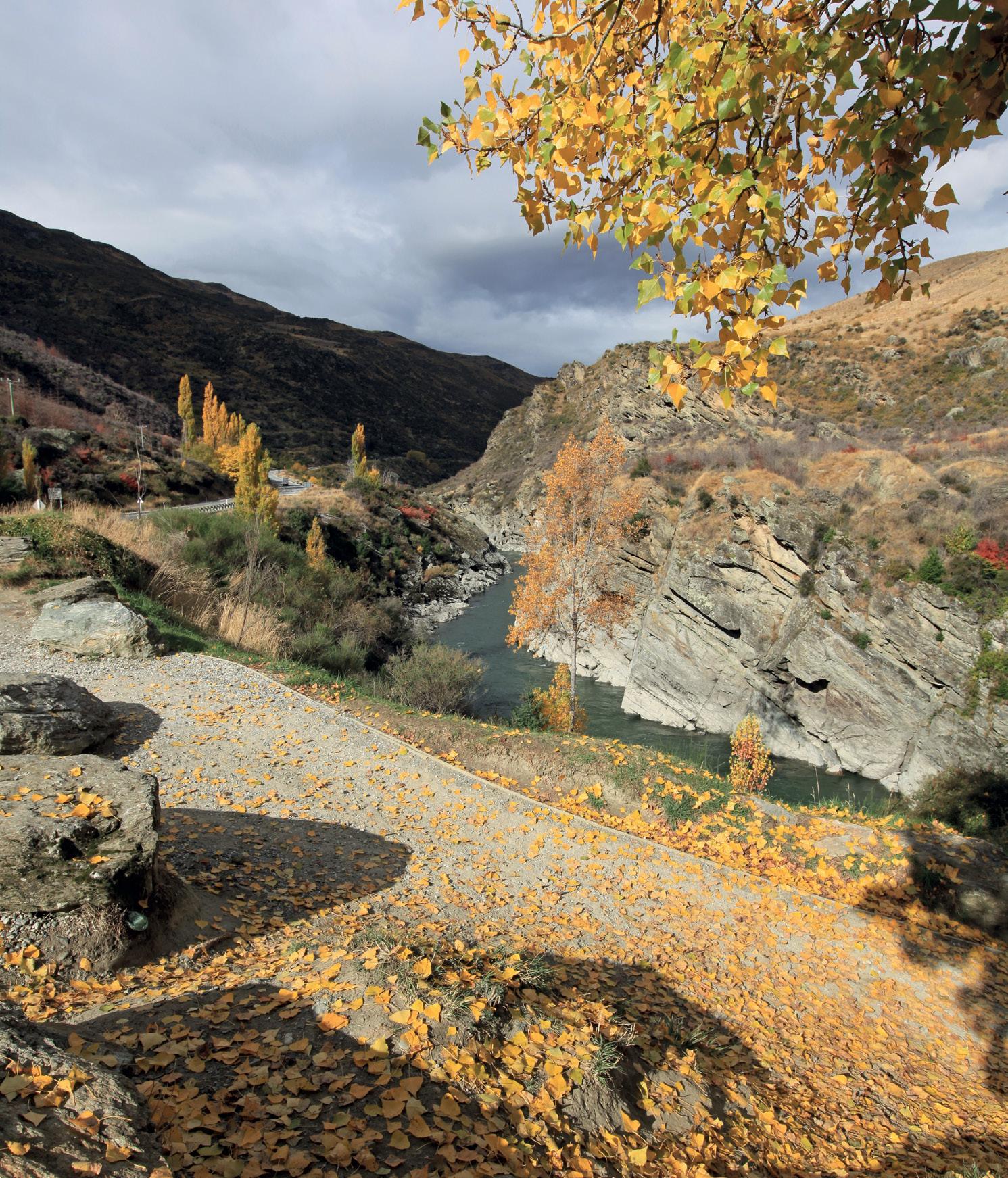
Northland, Auckland, Waikato, Bay of Plenty
• Temperatures are most likely to be above average (45 percent chance).
• Rainfall totals are most likely to be near normal (45 percent chance) for March–May 2025 as a whole. Dry spells are likely, including the beginning of the outlook period.
• Soil moisture levels and river flows are about equally likely to be near normal (40 percent to 45 percent chance) or below normal (45 percent chance).
Central North Island, Taranaki, Whanganui, Manawatu, Wellington
• Temperatures are most likely to be above average (50 percent chance).
• Rainfall totals are about equally likely to be near normal (40 percent chance) or below normal (35 percent chance). Dry spells are distinctly possibly, including the beginning of the outlook period.
• Soil moisture levels and river flows are both about equally likely to be near normal (40 percent to 45 percent chance) or below normal (45 percent to 50 percent chance).
Gisborne, Hawke’s Bay, Wairarapa
• Temperatures are about equally likely to be above average (40 percent chance) or near average (35 percent chance).
• Rainfall totals are about equally likely to be near normal (40 percent chance) or above normal (35 percent chance).
• Soil moisture levels and river flows are both about equally likely to be near normal (40 percent to 45 percent chance) or below normal (35 percent to 40 percent chance).
Tasman, Nelson, Marlborough, Buller
• Temperatures are most likely to be above average (45 percent chance).
• Rainfall totals are about most likely to be near normal (45 percent chance).
• Soil moisture levels and river flows are both about equally likely to be near normal (45 percent chance) or below normal (40 percent chance).
West Coast, Alps and foothills, inland Otago, Southland
• Temperatures are most likely to be above average (50 percent chance).
• Rainfall totals are about equally likely to be below normal (40 percent chance) or near normal (35 percent chance). Periods of unusual dryness are likely, interspersed with rainfall events.
• Soil moisture levels are about equally likely to be below normal (45 percent chance) or near normal (40 percent chance). River flows are equally likely (45 percent chance) to be below normal or near normal.
Coastal Canterbury, east Otago
• Temperatures are about equally likely to be above average (40 percent chance) or near average (35 percent chance).
• Rainfall totals are about equally likely to be above normal (40 percent chance) or near normal (35 percent chance).
• Soil moisture levels and river flows are most likely to be near normal (45 percent chance).
Probabilities (or percent chances) are assigned in three categories: above average, near average, and below average. In the absence of any forecast guidance there would be an equal likelihood (33 percent chance) of the outcome being in any one of the three categories. Forecast information from local and global guidance models is used to indicate the deviation from equal chance expected for the coming three-month period.
This is an extract of the Seasonal Climate Outlook published by NIWA.
Most of our planet is covered in water, but only 2.5% of that water is fresh –meaning fresh water is a precious global resource that needs to be managed wisely.
Adapted from a graphic in the book Knowledge is Beautiful
David McCandless, Information is Beautiful
Data: https://geni.us/KIB-WaterWorld
Sources: US Geological Survey, Food & Agriculture Org of the United Nations (FAO)
The largest proportion of fresh water consumption by humans goes to agriculture, which uses 73%. While some is for stock drinking water, most is for irrigation used in food production, which is why striving for best practice is so important.
Best practice irrigation sends water to the roots of a plant, which moves to its leaves and then evaporates into the atmosphere – feeding the natural cycle so that fresh water recirculates.

Brian Cameron was a trailblazer in the farming and agribusiness sectors whose enduring legacy is woven into the fabric of New Zealand’s economy and communities.
The retired Ashburton farmer, author, and agricultural industry pioneer, who is hailed as a “true legend”, died in December 2024, aged 93 years.
Passionate about all things farming, Cameron knew full well the trials and tribulations of the early days of toiling on the land.
He always had a vision to do much more, not only on his own land but also for the farming industry nationwide.
The forward-thinking Mid Canterbury farmer pioneered deep well irrigation, pressurised underground mainlines, and overhead sprinklers; innovations that not only transformed his own operations but set the standard for irrigated agriculture nationwide.
In 2009 Cameron launched his book Liquid Gold, his record of the journey of irrigation in Mid Canterbury from that water-breaking day in 1968 that turned his farm into an oasis.
The book chronicles the value of water to the district and the challenges faced by those whose vision it was that water could one day turn Mid Canterbury into the agricultural powerhouse that it is today.
Cameron was passionate about the cooperative approach to community-related
enterprises, and in 1979 he joined the New Zealand Farmers Co-operative Association steering committee as one of two South Island representatives from Federated Farmers.
In 1982, Brian joined the steering committee for the New Zealand Agricultural Cooperative Association, which was officially formed in 1984. He was its first chairperson, and its public face for many years, leading that organisation and its successor, the New Zealand Co-operative Association (now Cooperative Business New Zealand), until 1998.
Brian served 20 years on the board of the Primary Producers Co-operative Society (PPCS), which is now known as Silver Fern Farms. He spent four of them as deputy chair, and was a Canterbury Frozen Meat (CFM) board member for several years prior to the PPCS takeover. He was the foundation chair of the NZ Irrigation Association, now IrrigationNZ, which was formed to promote irrigation interests nationally and represent industry to government and wider water stakeholders.
He was a leader in Federated Farmers at both branch and executive level, and was fully involved in the formation of Ravensdown Fertiliser and the Electricity Ashburton co-operatives.
Agricultural education was close to Brian’s heart and for 25 years he and his wife Norma
hosted Lincoln University class visits to their farm properties. He was a farm tutor for four years, a committee member of the Lincoln University Alumni Association for 10 years, and president for 2 years.
He served 20 years on the Lincoln University Council and in 2001 was awarded the university’s coveted Bledisloe Medal for outstanding contributions to New Zealand’s land-based interests.
Cameron’s life is an example of persistence, vision, and integrity.
He faced challenges with a mix of professionalism, strategic planning, and quiet determination. His ability to outmanoeuvre opposition, often by pairing science-backed arguments with a dignified demeanour, was legendary.
Brian’s commitment to building a prosperous co-operative economy was matched only by his humility and generosity.
He viewed leadership as a means to serve others. His dignified approach to challenges, coupled with a relentless drive to create a better future, inspired all who worked with him.
Cameron’s legacy is a testament to the power of vision. He was proud of his passion, while remaining modest about his achievements and accolades.
Originally published in Farmers Weekly. Photo courtesy of Annette Scott.



Discover the Zimmatic difference.
Zimmatic pivot and lateral-move systems combine high-quality components with exclusive structural designs and innovative features for a long-lasting solution you can count on.
Contact your local Zimmatic dealer find out more.
